I haven’t written about my garden in nearly a month. While I was able to record and post my interview with Robin in segments over the last few weeks (a worthwhile detour) I’ve also been incredibly busy with work, baking, and family. I apologize for delaying this post, but I’m excited to share everything that has changed and everything I’ve done over the last four weeks.
For me, fall planning is already coming into focus. Here in June, I’m starting to think about what I want to eat at the end of the year. I’ll need to start crops like Brussels sprouts and cauliflower in July in order to harvest them before it gets too cold, so now is the time to decide what will fill the beds from late summer into the cooler fall months.
There are dozens of filler vegetables and summer relay seedlings in the nursery, but there are still more seeds to direct sow outdoors. After a big harvest in the polytunnel, and another big harvest in July, I’ll transplant these vegetables and sow the final summer seeds.
Summer hasn’t even officially begun yet, but I’m already starting to feel the grief of its passing.
Outside, harvests, plant maintenance, pest monitoring and control, and fertilization have overtaken my to-do list. I have to be strategic about when I walk through the garden because, if I wander out on a busy day, I’ll inevitably spot something that needs doing and get stuck in there!
In the kitchen, we’ve been enjoying the bright flavors and wide variety of textures that late spring and early summer bring. I finally dried enough basil to fill a pint jar and still have plenty more to harvest! I’m still working through the rest of the herbs, but this felt like a small victory (iykyk).
I’ll wrap up this post by giving some updates on the red pepper trial I announced back in April, but first, let’s take a look at what’s coming out of the garden.
Harvest
Radicchio
The beginning of June saw the final harvest of radicchio from the garden. The heads came out well, but I waited about one week too long before cutting them out. I’ve grown the green Virtus sugar-loaf type radicchio before, so I knew what to expect with that variety and ended up harvesting the most beautiful loaves of my life.
The Fiero variety was trickier. I wanted to give it as much time as possible to form large, dense heads. Every day, I went out poking and prodding to see if they’d firmed up. But when I noticed some leaf tip burn starting, I knew I’d pushed it a little too far.
Although I got a bunch of beautiful heads, most had small patches of leaf tip burn on the outer leaves. They were edible and quite delicious, but because the plant tissue was slightly damaged, they were unviable for long-term storage.
So, instead of storing them, we decided to eat them right away. My husband went on a BBQ frenzy so I made some coleslaw to go with it. I shredded up a few heads, julienned some carrots, sliced up the last few radishes in the fridge, and topped it with a homemade coleslaw dressing. It was really good!
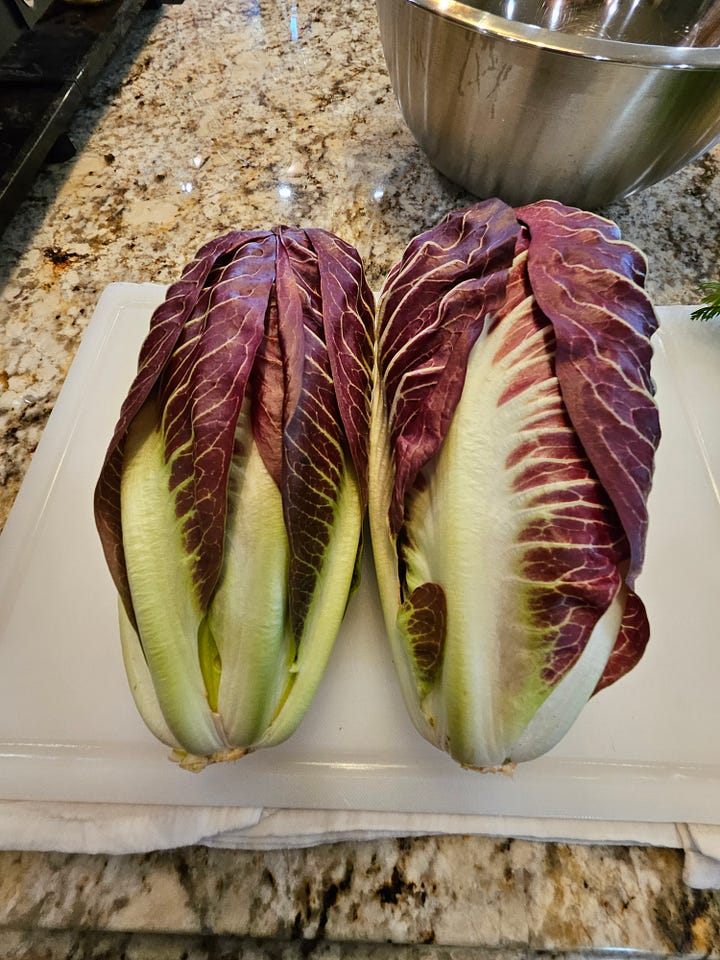

For the rest, we cut them in half and grilled them until charred, then drizzled with olive oil and balsamic vinegar, and finished with flaky salt. Highly recommended.
Carrots, Peas, and Bunching Onion
I started my carrots two weeks early this year, on the last day of March. It was a risk, because a late spring hard freeze could have wiped out the whole crop. Luckily, it paid off for me and I was able to begin harvesting carrots the first week of June.
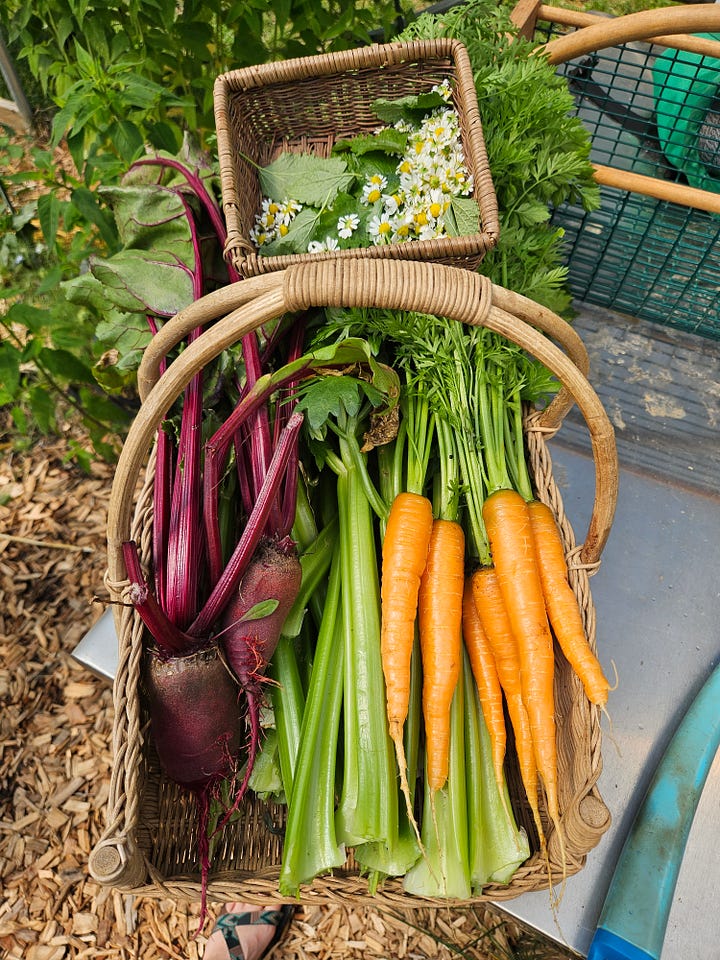
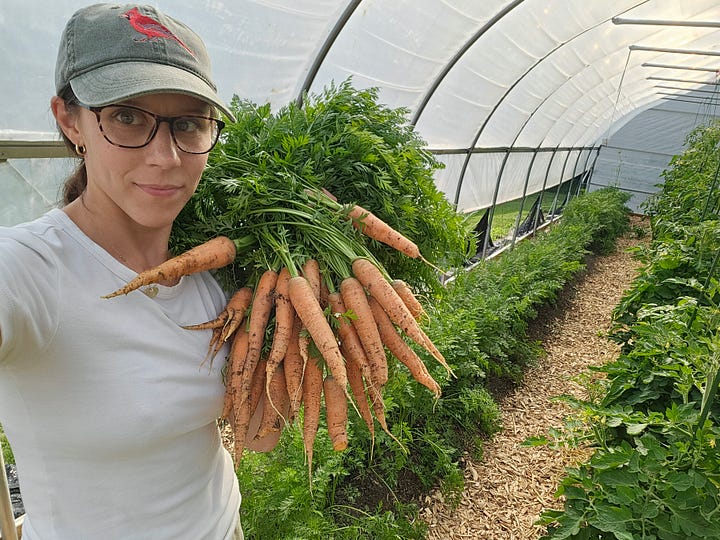
My Napoli variety are early maturing (taking only 55 days, though mine took at least 65 days), so they were the first to size up, but the others are following close behind. This week, I’m planning to pull each carrot that is of a decent size—regardless of variety—for preservation. I was only able to put a little over seven pounds of peeled carrot in the freezer last spring, so I’m hoping to quadruple that this year!
In the meantime, we’ve been enjoying fresh carrots in coleslaw, stir fries, and, most recently, in carrot cake.

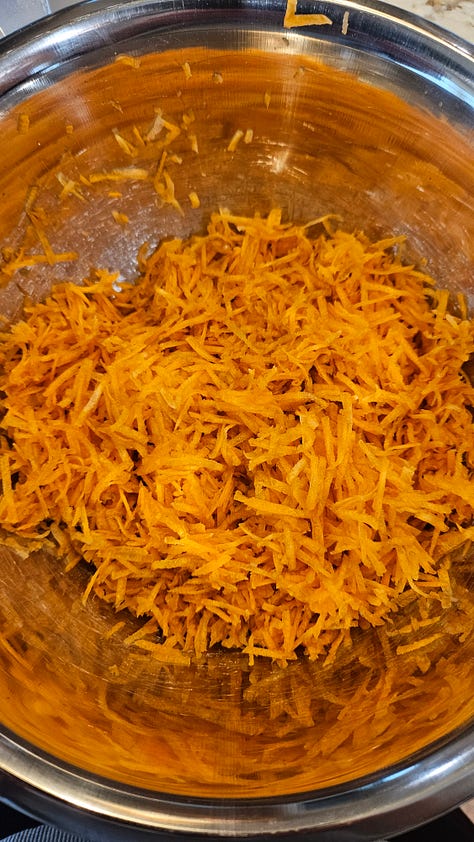
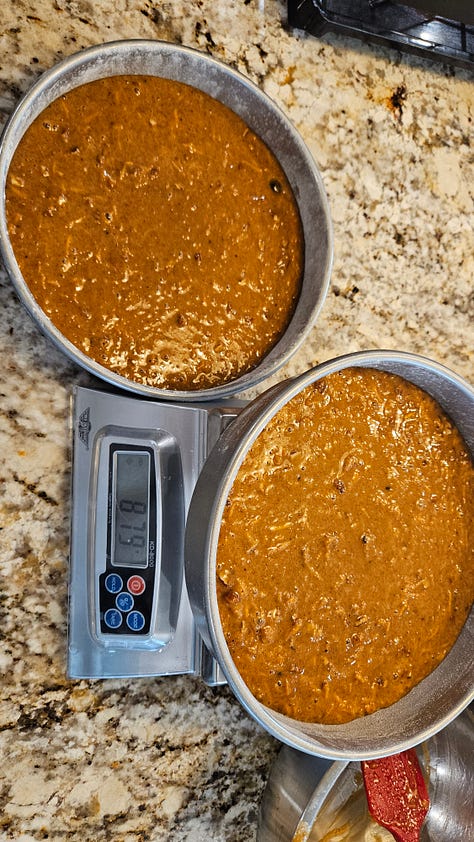
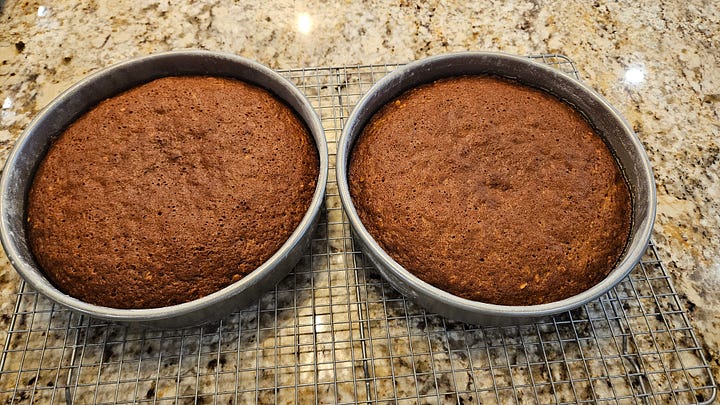
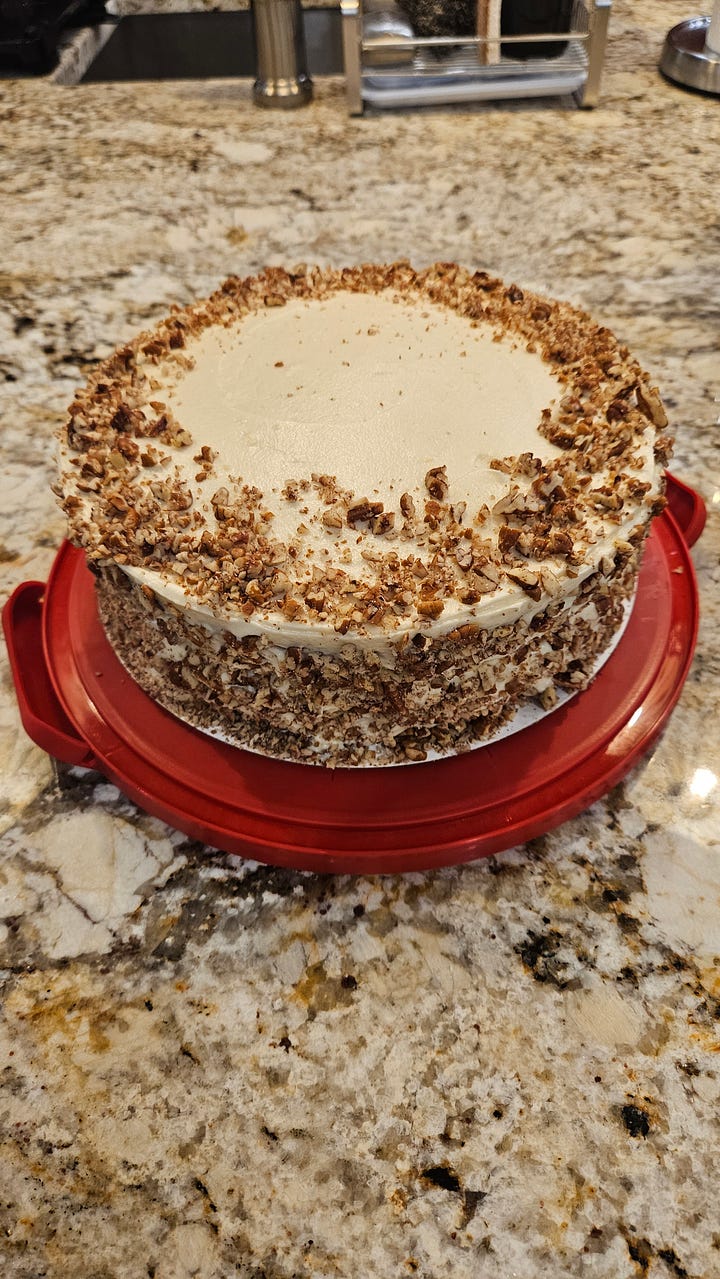
Speaking of stir fry, I included some snow peas and bunching onions which are both firsts for my garden.
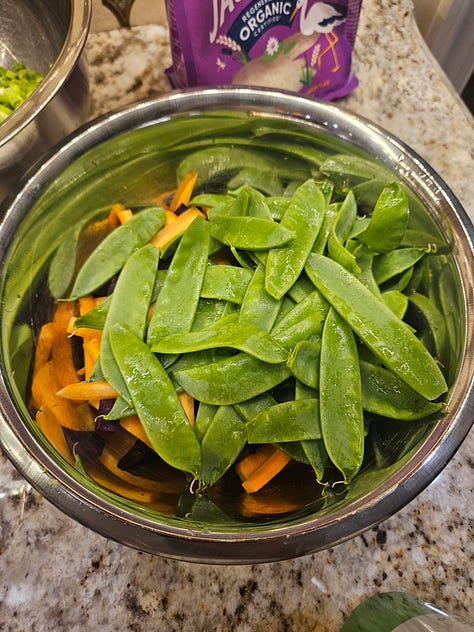
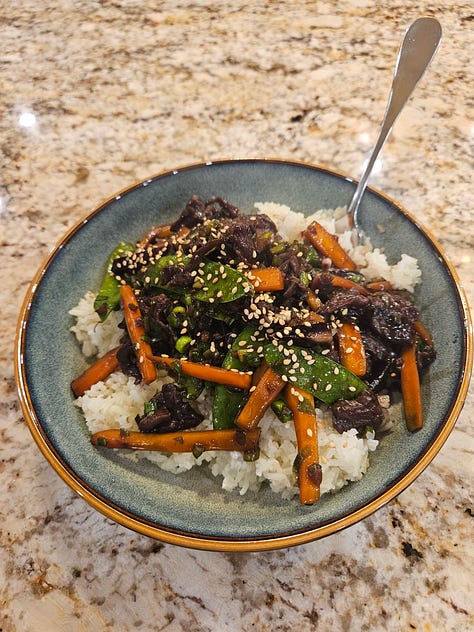
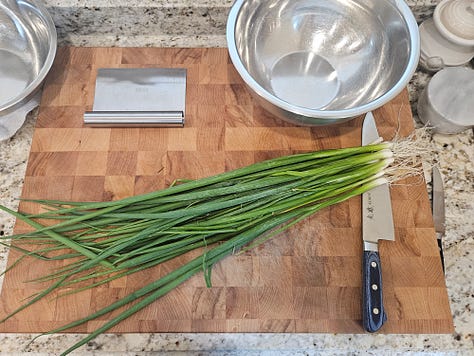
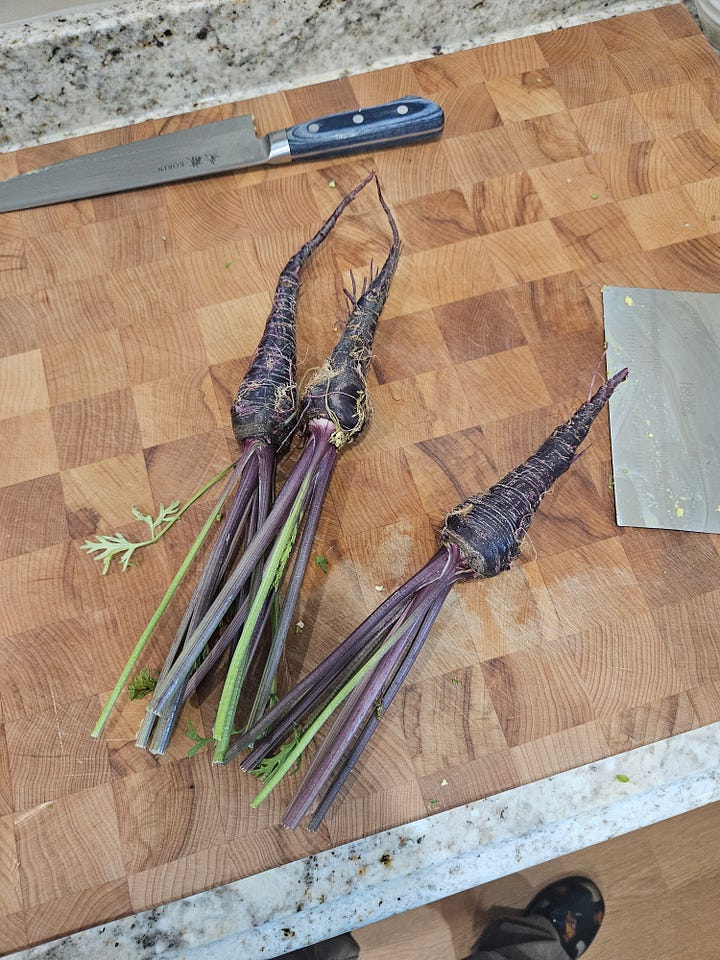
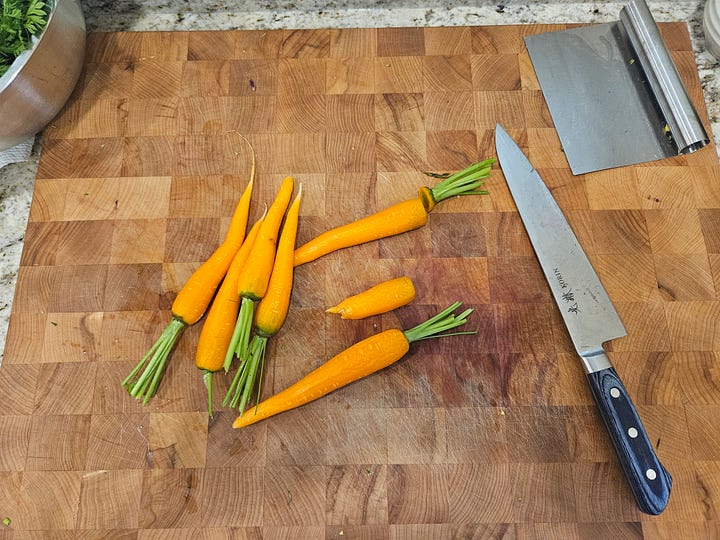
My pea plants have been thriving in the cooler than normal weather we’ve been experiencing lately and have nearly reached the top of their trellis. Next year I’ll definitely be using a taller one!
I’m not sure because I’ve never grown snow peas before, let alone this variety, but I think the cooler weather has made them exceptionally sweet. They are a treat straight off the vine.
The same could be said of the bunching onions as well, since most alliums prefer cooler weather. Regardless, I think I’ll be needing to harvest a large part of my bunching onions soon, before they start to wither away in the summer heat.
Beets, Celery, Leeks
My beets are starting to size up nicely. When they reach around 2 inches in diameter, I pull them and store them in the fridge with their tops removed. Unlike me, my chickens love the greens. I’ve found that beets store incredibly well without their tops, as long as they’re kept in an airtight container with a bit of humidity.
When I have a good stash of beets in the fridge I’ll make some Ukrainian borscht or pickle them for my family.
Celery is a wonderful vegetable to grow because it will last in the garden all year. There is no need to harvest full plants at once. If you take one or two stalks from each plant on a regular basis, you can harvest nearly unlimited celery. They hold well in the heat even though they are technically a cool-weather crop. Even so, I will still start a fall crop of celery to refresh my supply with younger plants.
I store celery in my fridge in a vacuum sealed bag after cutting off the leaves and then washing and drying the stalks. We’ll use this supply of celery in anything requiring a mirepoix and to make chicken and beef stocks. I’ve found that homegrown celery, at least this Merengo variety, is a little more potent than the store-bought kind. So, it doesn’t make for as great of fresh eating unless you really like the taste of celery!
Leeks, like beets and celery, store well once their leaves and roots are removed and the stalks are washed and dried.
I made a snap decision to harvest the vast majority of my leeks when packing a vegetable box for a friend. I didn’t take any pictures of my harvest because I was in a rush, unfortunately, but the leeks turned out well even though they aren’t as thick as I’d hoped they would be.
That said, I’m glad I harvested them early because I found some sort of tiny fly larvae chewing through the outer leaves. If I would have waited longer, the leeks may have become compromised.
I have around twelve in the fridge now that I intend to use or sell this week or next. We enjoy using leeks in poached fish dishes, pasta with mushrooms, or in potato soup.
Potatoes
The potato plants have already flowered, so I know I can start pulling them if I want new potatoes to eat for dinner. I planted Yukon Gold, Satina, and Red Chieftan mid-season varieties, alongside my Elba and Burbank Russet storage varieties.
This week I started to pull some Red Chieftans out of the ground!
When I pull new potatoes like this, we enjoy them in braised dishes or simply roasted! I intend to leave most to cure in the ground, but I can’t help myself sometimes.
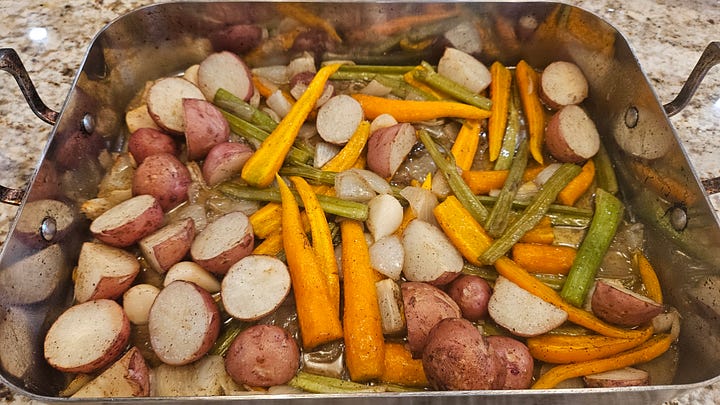
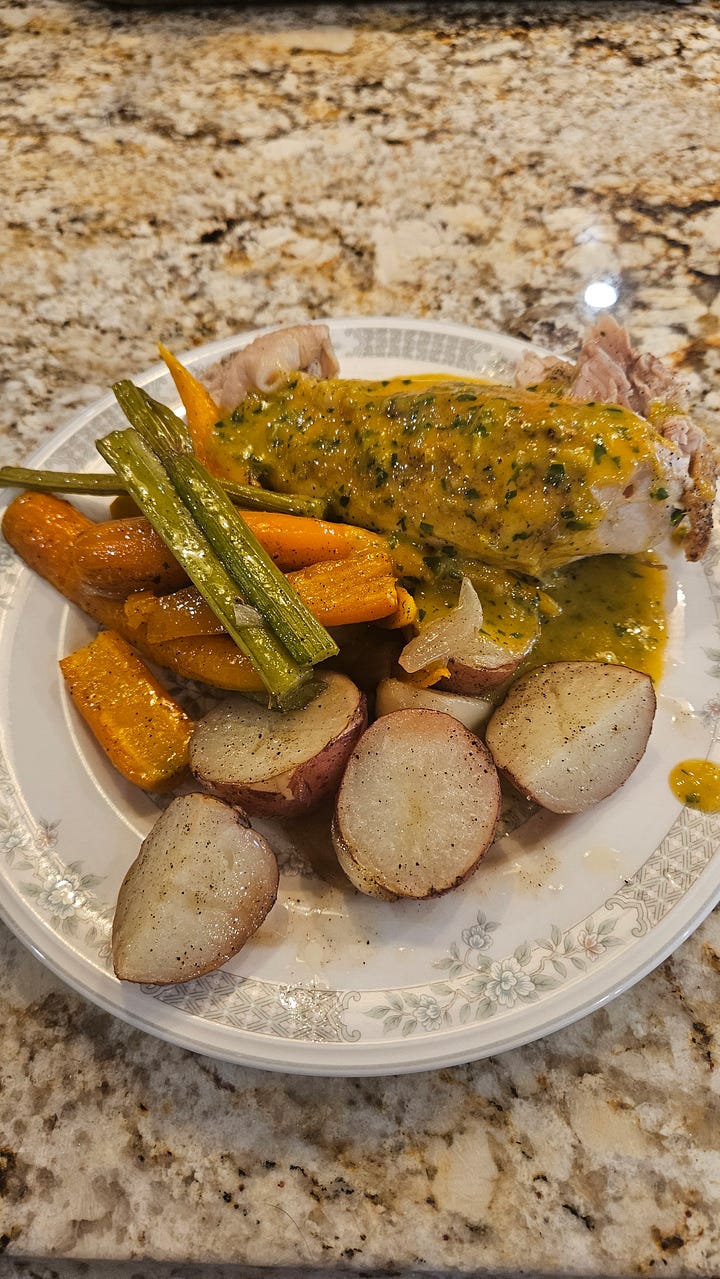
Herbs
My thyme, oregano, marjoram, and mint have begun flowering, and I don’t prune off the flowers in order to attract pollinators. Bees love their flowers!
In their place, I have an abundance of dill, parsley, and basil that I am harvesting regularly. We store parsley fresh in the fridge, but I like to dry dill so I can use it in pickling later on in the summer.
Likewise, I’m drying basil this year in an effort to have enough preserved to last through the year. I’ve dried a full pint so far, but add more to the dehydrator every time I prune the plants.
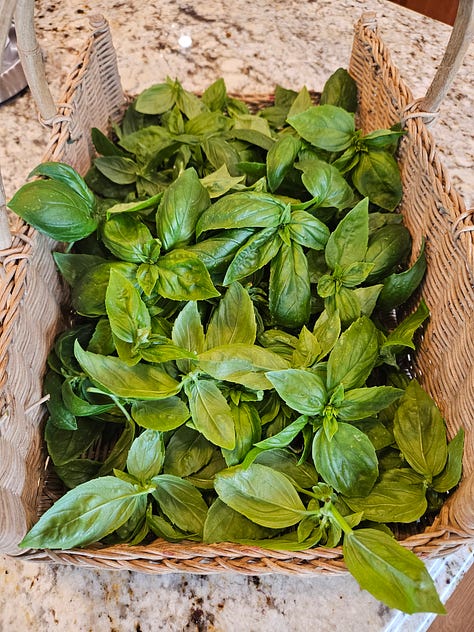
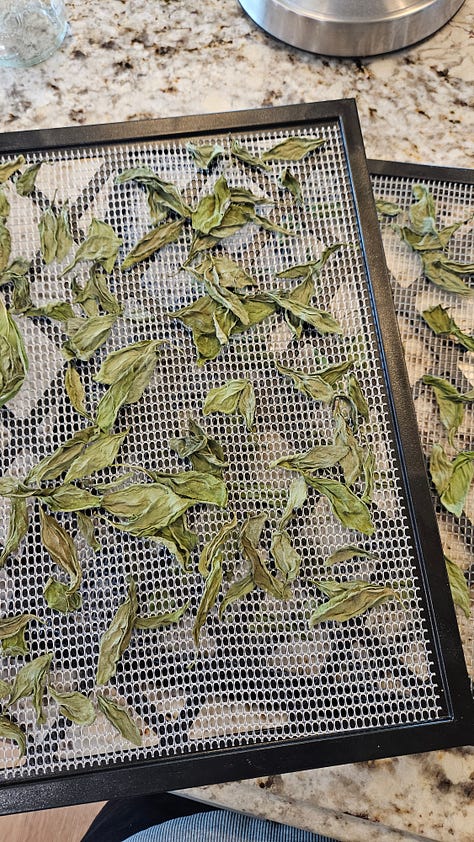

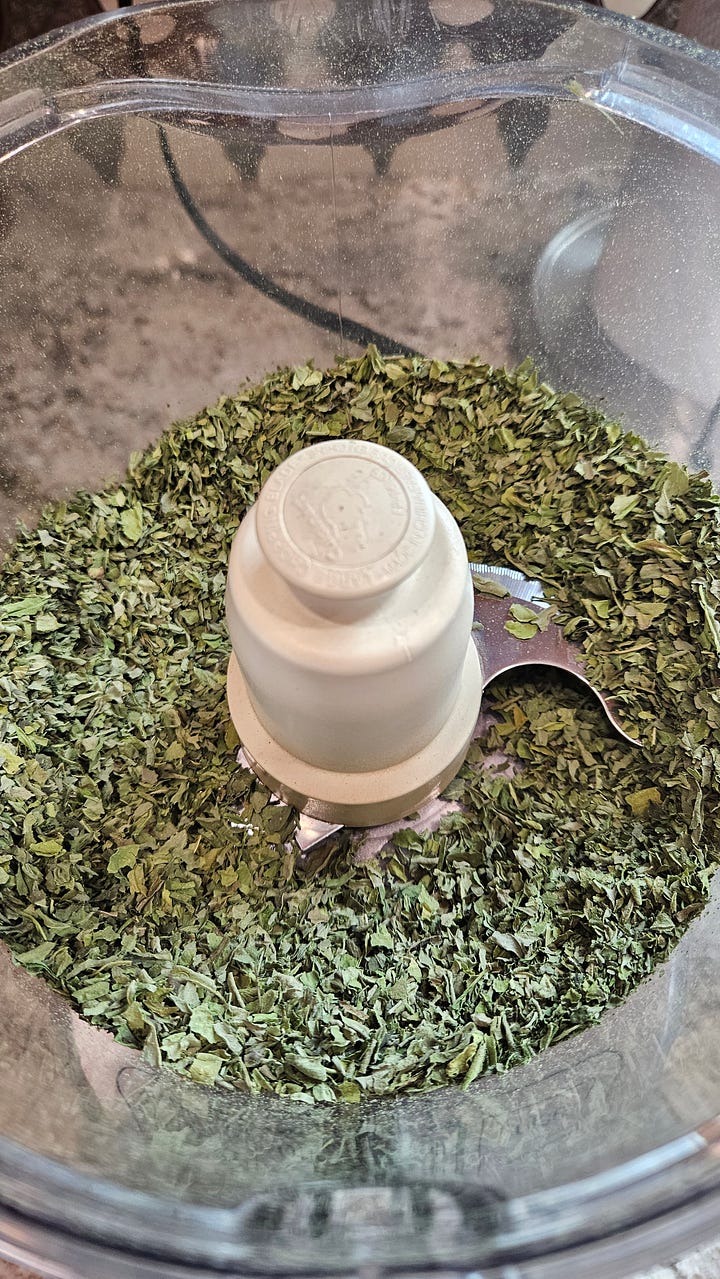

What I’m Sowing
After harvesting the red radicchio, I finished sowing the dry beans in their place. I already sowed Rattlesnake pole beans and Quincy pinto beans, but now I’ve added Eclipse black beans and red kidney beans, too. All but the Rattlesnake variety are bush beans, so they won’t need support, making them easy to manage.
I’m very curious to see what kind of yield I can get out of one bed of dry beans. I’ve set a modest goal of 3 pounds total (they’re light once dry), or roughly a quart of each type.
Soon, I’ll be sowing winter squash, more summer squash, and either more dry beans or green beans in the polytunnel once the carrots are fully harvested.
In the nursery, I’ve started my determinate tomato varieties that will take the places of the potatoes, onions, shallots, and garlic near the end of July.
I’ve also potted up the filler vegetables and new tomatillos into 4-inch pots. The tomatillos will be transplanted outdoors soon, and the rest will move outside as new gaps open up. I’m especially curious to see how the brassicas handle the summer heat. They’re all supposed to be heat-tolerant, but I’ll be putting that to the test.
Some of the filler vegetables have already made it outside. Under the shade of the cucumber vines, I’ve transplanted Magenta and Albachiara summer crisp lettuces. I’m hoping that a combination of heat tolerance and shade will let us enjoy tender leaf lettuce right through mid-summer.
Maintenance
At this point in the season, maintaining what’s already planted is easily a full day’s work. We have received a ton of rain over the last four weeks (roughly ten inches) and the plants have exploded with growth!
Fertilizing
That being said, so much rain leaches nutrients from the soil. This isn’t necessarily good, but there is a silver lining.
Just like too little available nutrients can inhibit a plant’s growth, too much can do the same. In the worst cases, over-fertilization can damage plants by pulling water from the roots or by encouraging excessive leafy growth that attracts pests.
All this is to say that I’m trying to see the silver lining of having most of the fertilizer I applied early in the year washed away over the course of several weeks.
So, I’m trying to look at the upside: much of the fertilizer I applied earlier this year has likely been flushed out, giving me the chance to essentially start from scratch and have more control over what nutrients are available going forward.
For fruiting crops like tomatoes and peppers, I’m applying high-phosphorus and potassium fertilizers on a bi-weekly schedule to encourage flowers, fruit development, and strong root systems. In contrast, for plants that are just getting established or grown primarily for their foliage, I’m using higher-nitrogen fertilizers or a balanced formula.
Pepper/Eggplant Update and the Compost Tea Rabbit Hole
As you may know if you read my last post, my peppers and eggplants were struggling very hard. Their leaves were yellowing and the growth had noticeably stalled.
Right after posting, I applied a balanced fertilizer along with fish emulsion and waited to see if there were any improvements. In fact, I was hoping that the solution to the problem was as simple as a nutrient deficiency. Come to find out, it was!
Within a week, the plants began putting out new growth that was a lovely deep green.
As time went on, growth accelerated, and even the older leaves started to green back up. Now they look as lively as ever!
Over the last few years, I haven’t typically needed to fertilize my peppers much during the growing season. Usually, the nutrition added when I flip my beds in fall and spring is enough to carry them through. So I was surprised to see how strongly they responded to additional fertilizer.
This sent me down a bit of a fertilizer rabbit hole.
My go-to fertilizers are made by Down To Earth, but they are granular. They take a longer time to be made available to plants by microorganisms in the soil, and while there are good organic, liquid fertilizers, I would be using them so often and on such a large scale that the cost would become burdensome over time.
I’d heard about making compost tea in the past but never really looked into it. Now that I realize I’ll need to provide more ongoing nutrition through the season, compost tea suddenly seems like exactly what I’ve been looking for. Not only does it use organic inputs, but it also inoculates the soil with beneficial microorganisms that help plants take up nutrients.
The inputs (like worm castings, fish hydrolysate, biochar, humic acid, etc.) are available to in large enough quantities and at low enough prices that I can fertilize my whole garden for an entire year for less than it would cost to buy liquid fertilizers. When combined with my regular granular applications of Down To Earth’s All Purpose or Bio Live, I think that compost tea will provide what’s been missing to my garden with an added bonus of increasing soil life!
I’m genuinely excited to give it a shot. I had originally grown comfrey this year thinking I’d just toss some leaves into a bucket of water and wait a few weeks (lol). But now I find myself fully immersed in researching all kinds of inputs.
I purchased TeaLAB’s 5-gallon system, which aerates the water to encourage rapid microbial activity. I’ve brewed two batches so far and applied it to every plant in the garden.
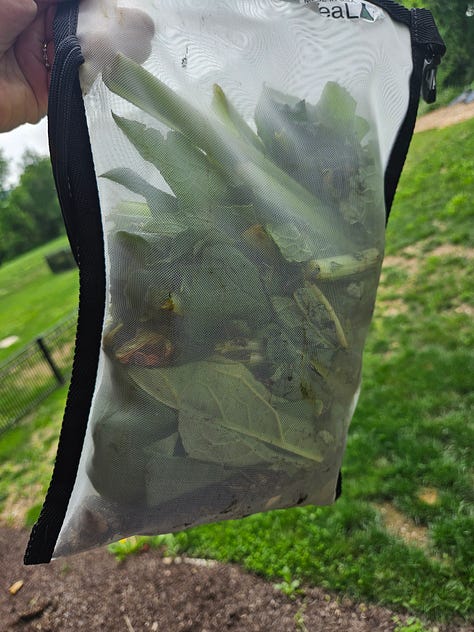
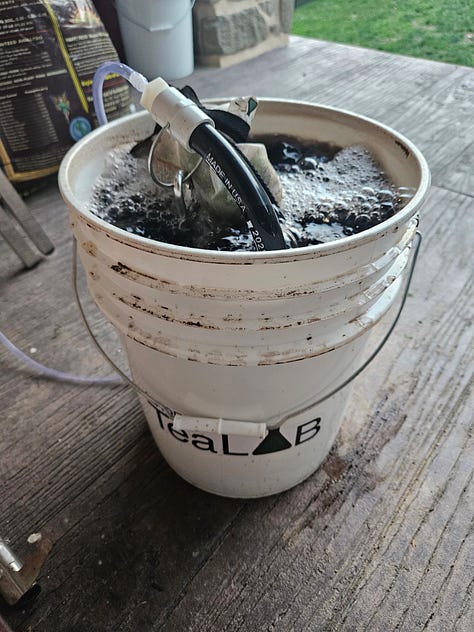
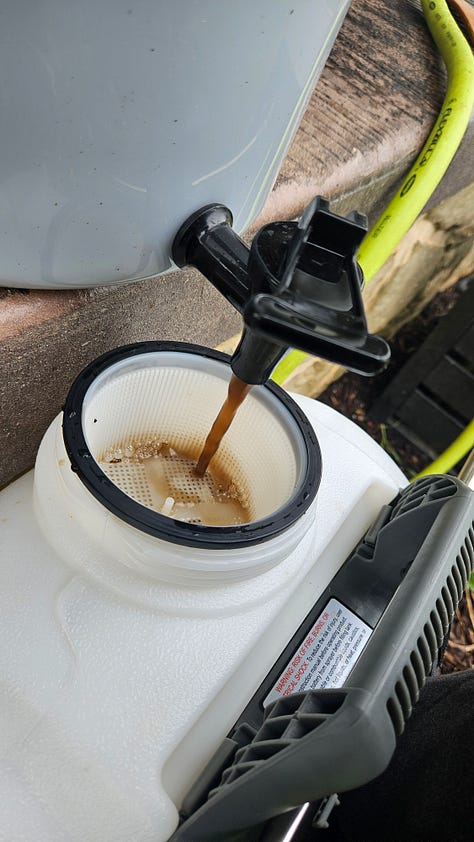
Right now, I’m applying it every two weeks during peak growing season at a 1:3 dilution ratio (tea to water).
Have you used compost tea before? Did it work for you? I would love to know if you’ve had success with it!
Pruning and Trellising
When it comes to workload, nothing demands more of my attention right now than pruning and trellising tomatoes. I check them regularly to keep each plant limited to two leaders, pruning off any other suckers as they appear. I also remove yellowing or dying leaves at the bottom, and occasionally thin healthy leaves that are overcrowding the canopy to keep airflow moving.
Pruning the tomatoes is enough already, but keeping up with their growth is something else. When I last posted, my plants looked like this:
I was chasing them up their stakes with Velcro tie, but they still had a long way to go. Now, they are long past their stakes. In the first week of June, I had to finish tying paracord across the truss so that I could tie the tomatoes to the top of the poly tunnel. Once that was done, I tied every stake to the paracord, which results in this:
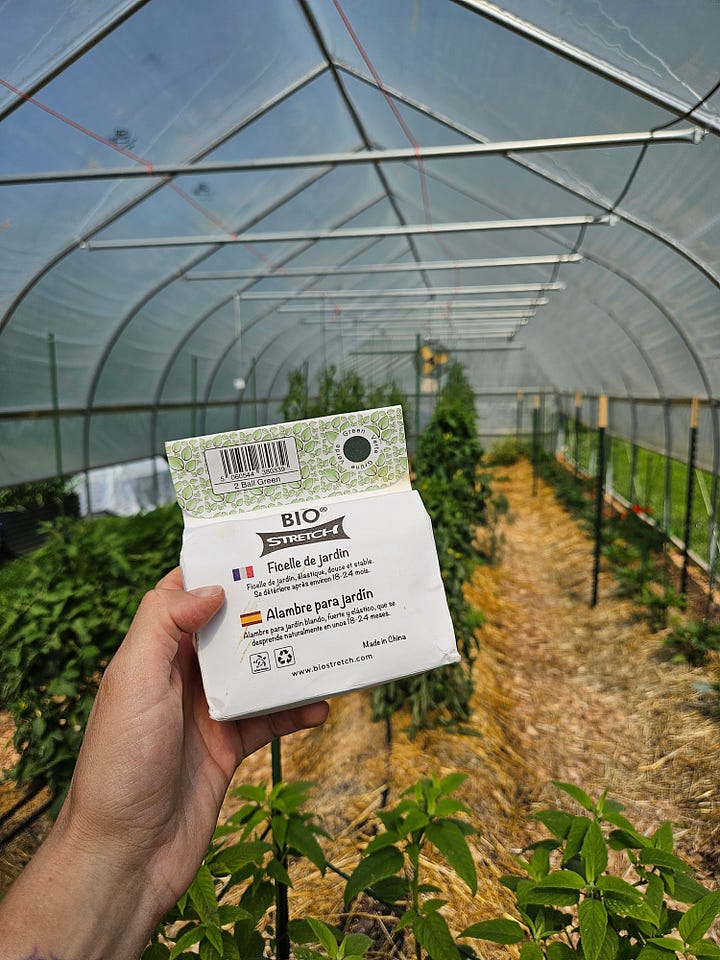
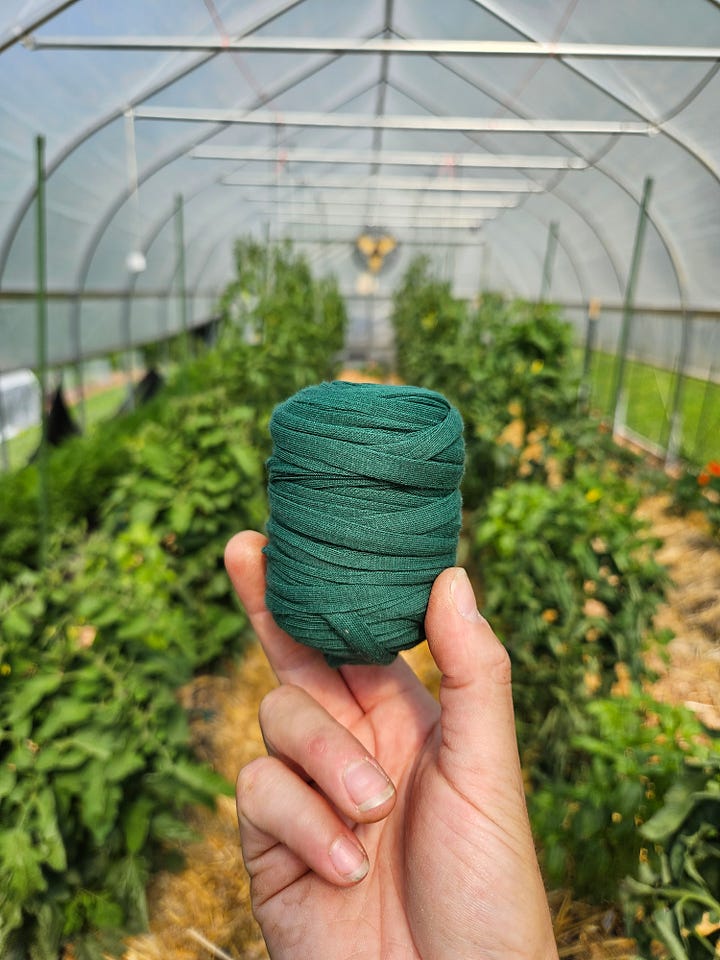
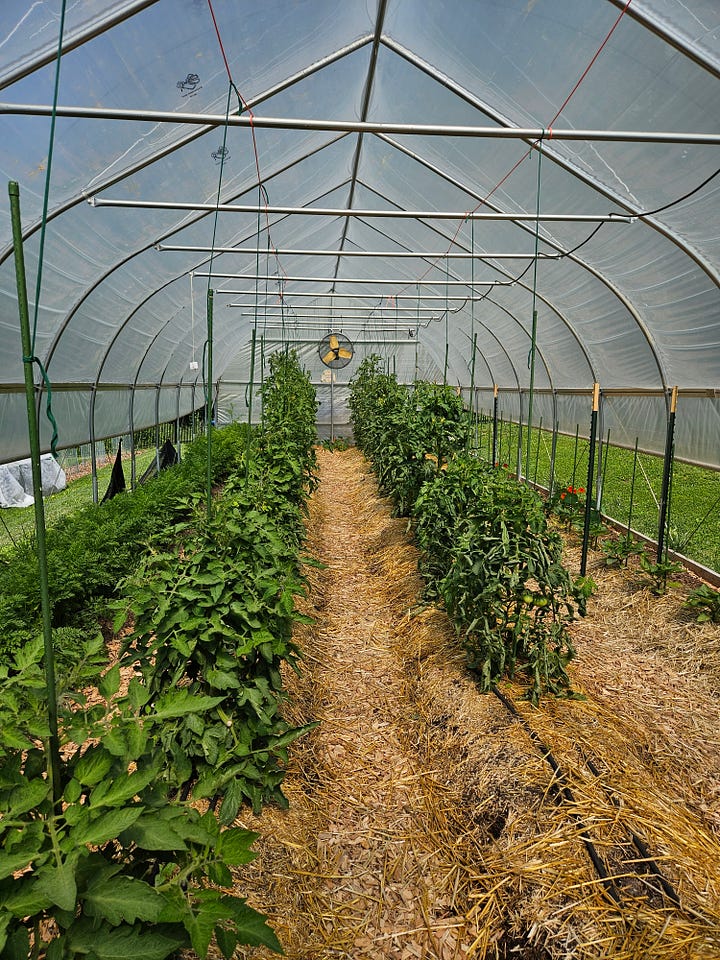
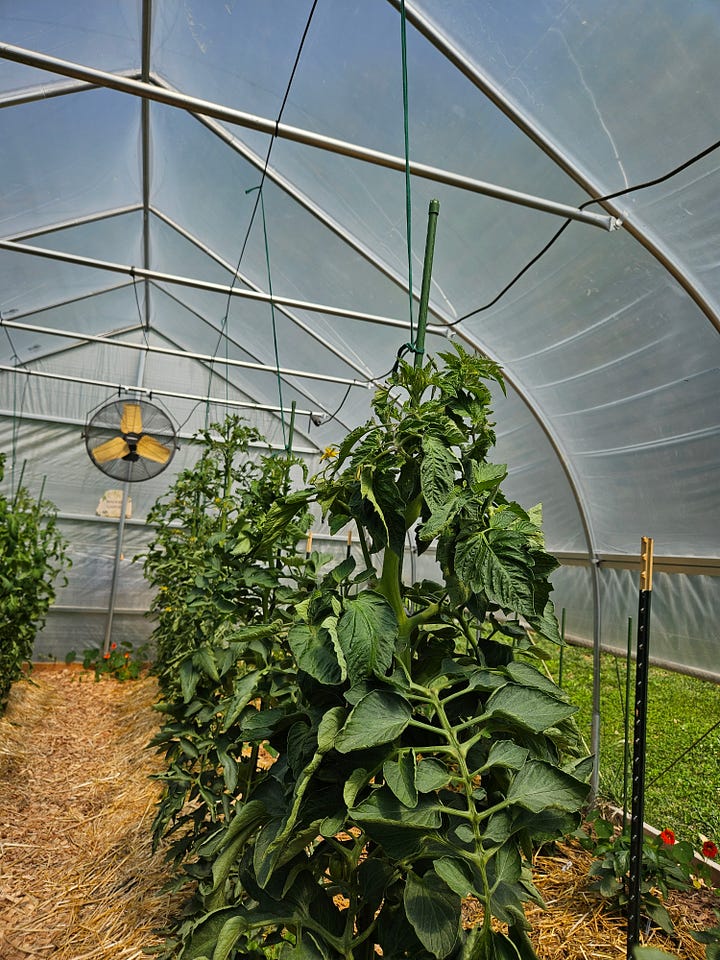
Now, the tomatoes are happily climbing up the Bio Stretch tie to the top of the polytunnel. They’re all indeterminates, so they’ll keep growing if I let them.
I briefly considered letting them flop over the paracord and begin growing back down toward the ground after they’ve reached the ceiling, but decided against that. Instead, I top them off once they reach the truss. That way they maintain their integrity and don’t crack or get damaged, which would invite disease.
As they grow, I simply twist them around the Bio Stretch to keep them supported vertically. The tie’s flexibility allows it to expand as the stems thicken, while still providing enough give to let the plants sway in the wind, reducing the risk of snapping or breakage.
Here’s how I do it (it’s much easier to do with two hands! lol):
I’m also keeping an eye on the peppers as they fill out. The hot varieties and Anaheims have grown enough that I’ve strung mason line between the T-posts I already had in place. This helps support the weight of both the branches and fruit, and keeps the plants from spilling into the walkways.
The bell peppers are slower-growing and bushier, so I may not need to trellis them for a few more weeks. Still, each pepper plant already has its own vertical stake for support.
The only other plants I’m currently pruning regularly are my basil and cucumbers. Basil needs to be pruned about every 3-5 days to prevent it from flowering and to encourage a bushier growth habit. As for my cucumbers, I’m pruning off their suckers (yes, they have suckers just like tomatoes!) when there are too many. I allow for some suckers, but prune them when the trellis starts to get crowded.
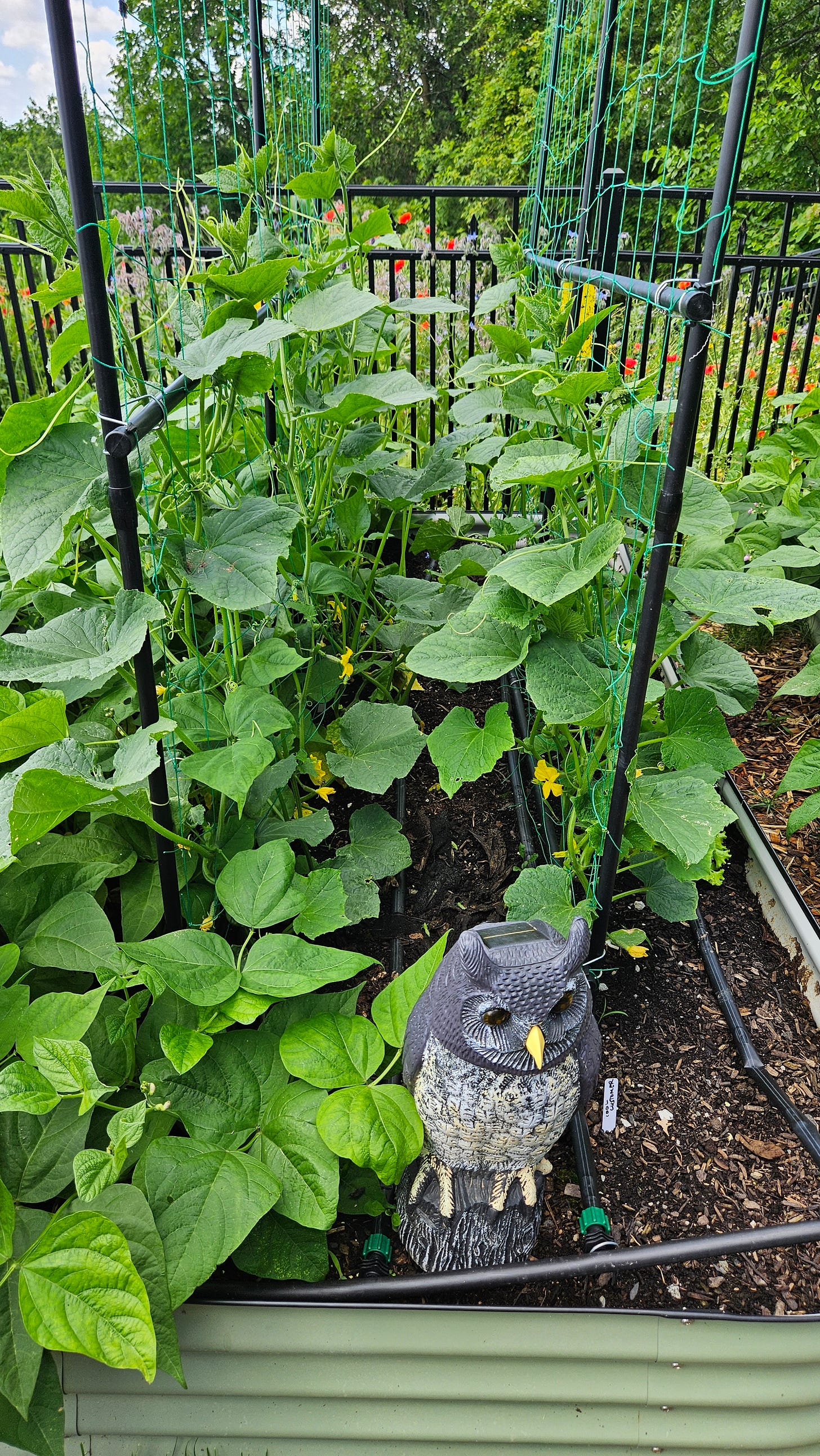
Pest Monitoring and Control
June and July are beetle season! Benign and beneficial beetles like June bugs and lady bugs come out at this time of year, but so do the pests. I spotted the first Japanese beetle recently chewing on my eggplant leaves. They aren’t picky eaters, so you have to check for them everywhere!
You can either drop them in soapy water or, do what I like to do, hand-crush them.
Another beetle I’ve seen a lot in my garden recently is the cucumber beetle. I’ve never had too big of an issue with these guys, but it seems like this year they’ll be a pain in my neck.
Cucumber beetles are much more flighty and nimble than Japanese beetles, so they’re harder to catch. However, hand-crushing or soapy water are still the best options to deal with them. I’ve been checking morning and night, when they’re most active, but I’ve also set out some yellow sticky traps to catch them when I’m not out there.
The sticky traps have also snagged some whiteflies and leafhoppers, an added bonus.
So far, I haven’t spotted any squash bugs or squash vine borers (eggs, larvae, or adults), but I’m checking under the squash leaves and along the petioles daily.
Red Bell Pepper Trial Update!
Now that my peppers are growing at full tilt, I am starting to notice some differences between the four red bell pepper varieties I’m trialing this year.
King Crimson
King Crimson has always been my go-to red bell pepper variety, but I’m trying to find if there’s a better option out there. These plants are relatively smaller and show a little distress in their leaves. The leaves are a bit crinkly when they should be smooth and broad.
There are lots of flowers and fruit buds, though. Overall, it looks like a healthy plant. But, let’s look at the others to compare.
Sprinter
This Sprinter plant is much larger than the King Crimson. It’s leaves are also more healthy, glossy, and smooth. That said, there are fewer flowers or buds.
Olly
Olly is larger than King Crimson, but slightly smaller than Sprinter. Its leaves are broad, smooth, and well-structured (although some have been nibbled on). It’s putting out a lot of new flower buds, which promises a good yield ahead.
Nitro
Nitro is about the same size as Sprinter, but its canopy is more open at the center. It has more flowers and buds than Sprinter, but the open growth habit could expose the developing peppers to sunscald. I’m curious to see if it fills out its canopy as it matures.
Otherwise, it’s a beautifully healthy and vibrant plant with a nice branching, bushy growth habit.
Verdict #1
Compared to the other three, the King Crimson isn’t looking like a winner at this stage. It’s small and a bit spindly. So, I’m not currently banking on it winning this trial.
Of the remaining three, I’m leaning toward Nitro right now. It’s as large as Sprinter, but with more flower buds. The open structure is a potential risk for sunscald, but I like its branching and the deep green color of its leaves.
It’s too early on to know how this will turn out, but I’ll take a guess anyway for fun! And science!
Now you take a guess!
Since peppers continue producing all the way into October, this trial will run for another two months. In July, I expect the plants to be loaded with green peppers, which will give me a better sense of their vigor and size. By August, I should be making regular harvests with enough fruit to start comparing yields more fairly.
I’ll post another update in mid-July, and declare the winner in August.
Looking Forward
I’m excited to share the results of my first big carrot harvest with you so keep an eye out for that next. I’m hoping for around 28 pounds of carrot to eat fresh or put in the freezer.
The garlic will be harvested soon, likely this next week. I’m crossing my fingers that the bulbs sized up well and that the curing process goes smoothly.
Beyond that, summer is shifting into high gear. The tomatoes are threatening me with days and days of canning and the beans are burgeoning with baby pods, ready to give me hours of picking to do. Some plants are winding down, but the next round of sowings and transplants are all lined up to take their places.
There’s plenty of work still ahead; more harvesting, preserving, fertilizing, pruning, and (my least favorite) pest patrol. For now, the garden is humming along beautifully and has, honestly, turned out much better than I planned or anticipated.
Thanks for following along. Happy gardening, and cheers to fifteen hour days!
Bonus points for making it to the end of this long post, and, as a reward, here are some pictures of a surprise I found last week:
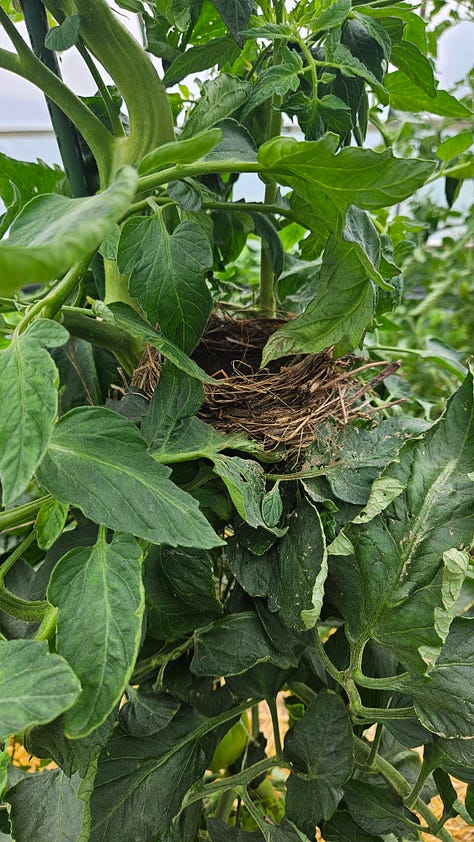
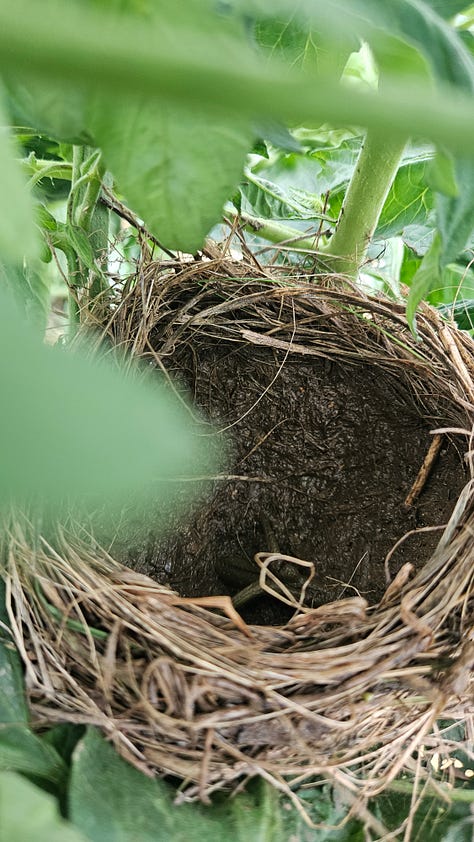
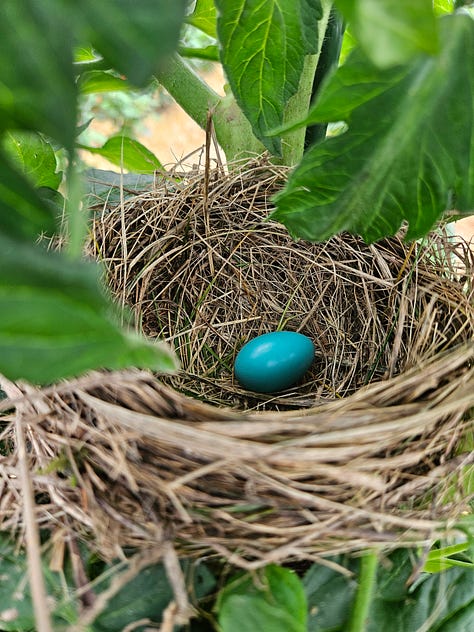
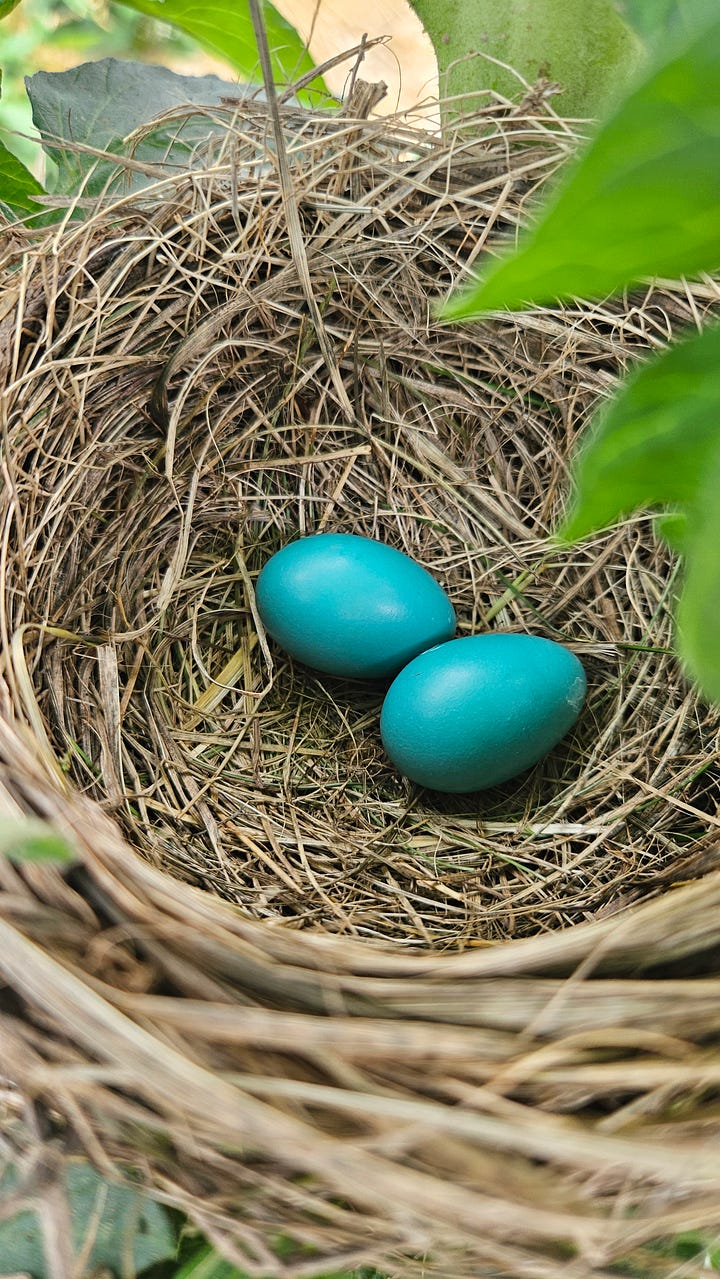

The Robin is annoyed every time I walk through the polytunnel, but it’s a fair exchange for living in there rent-free.





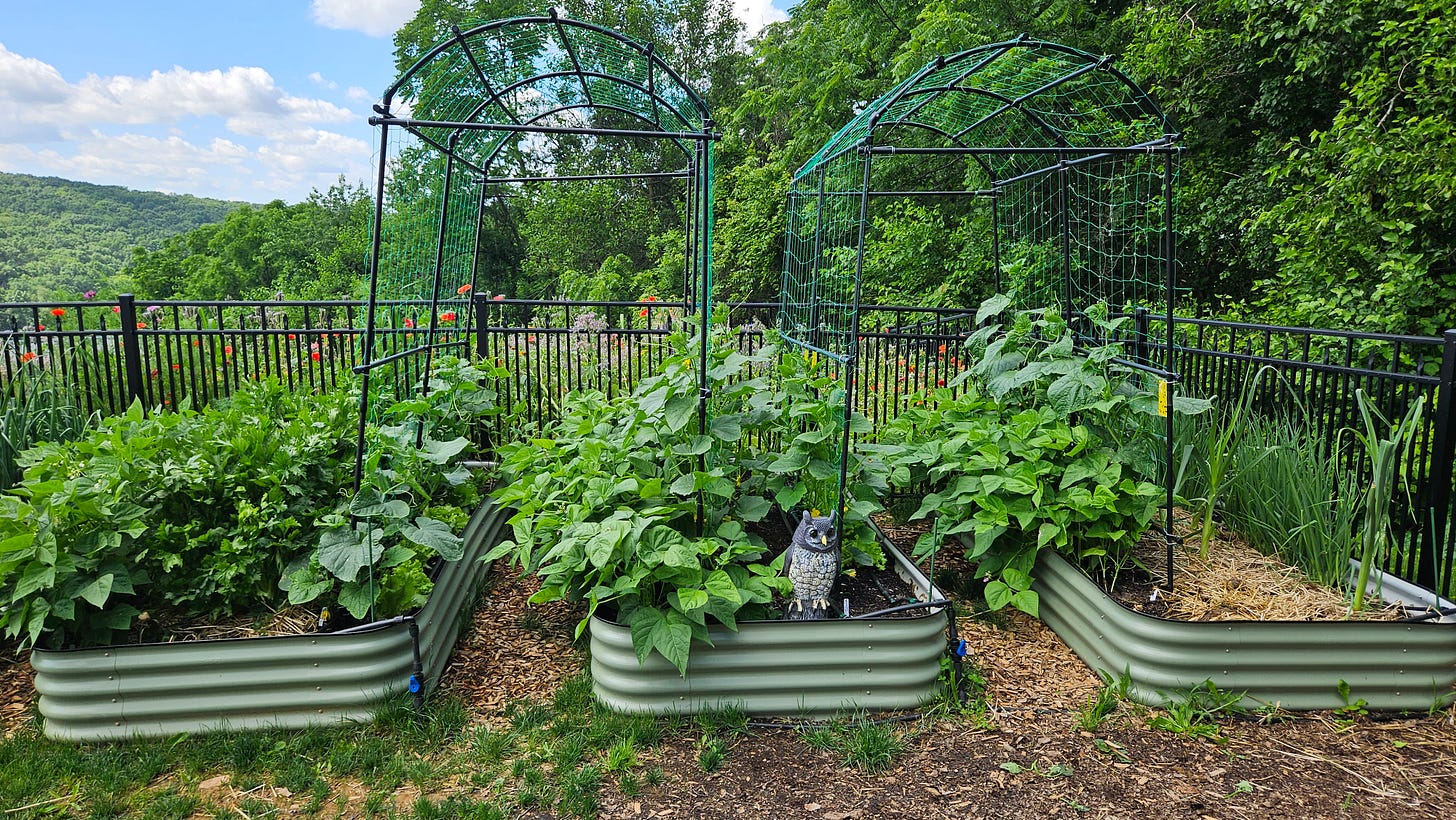
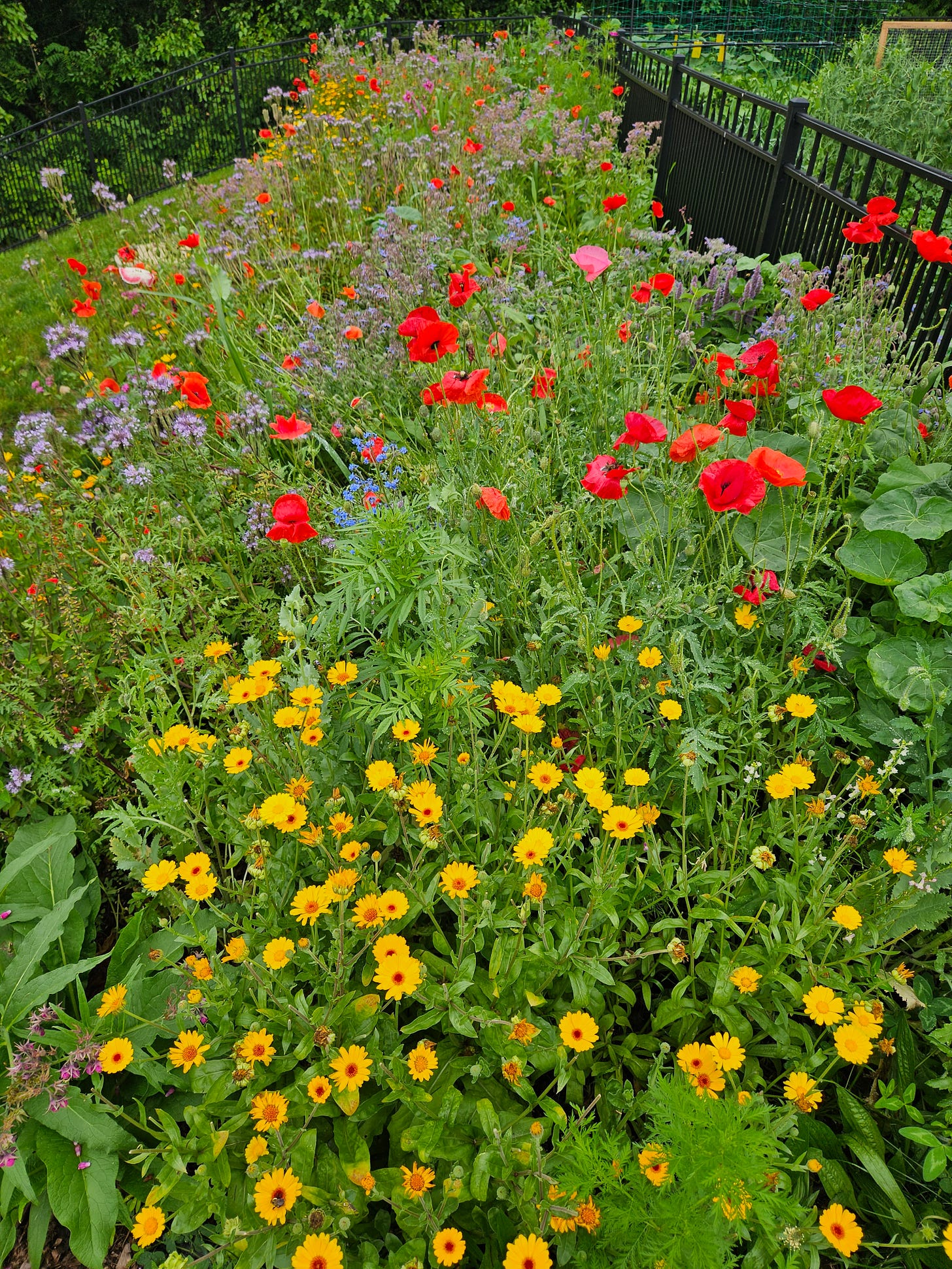
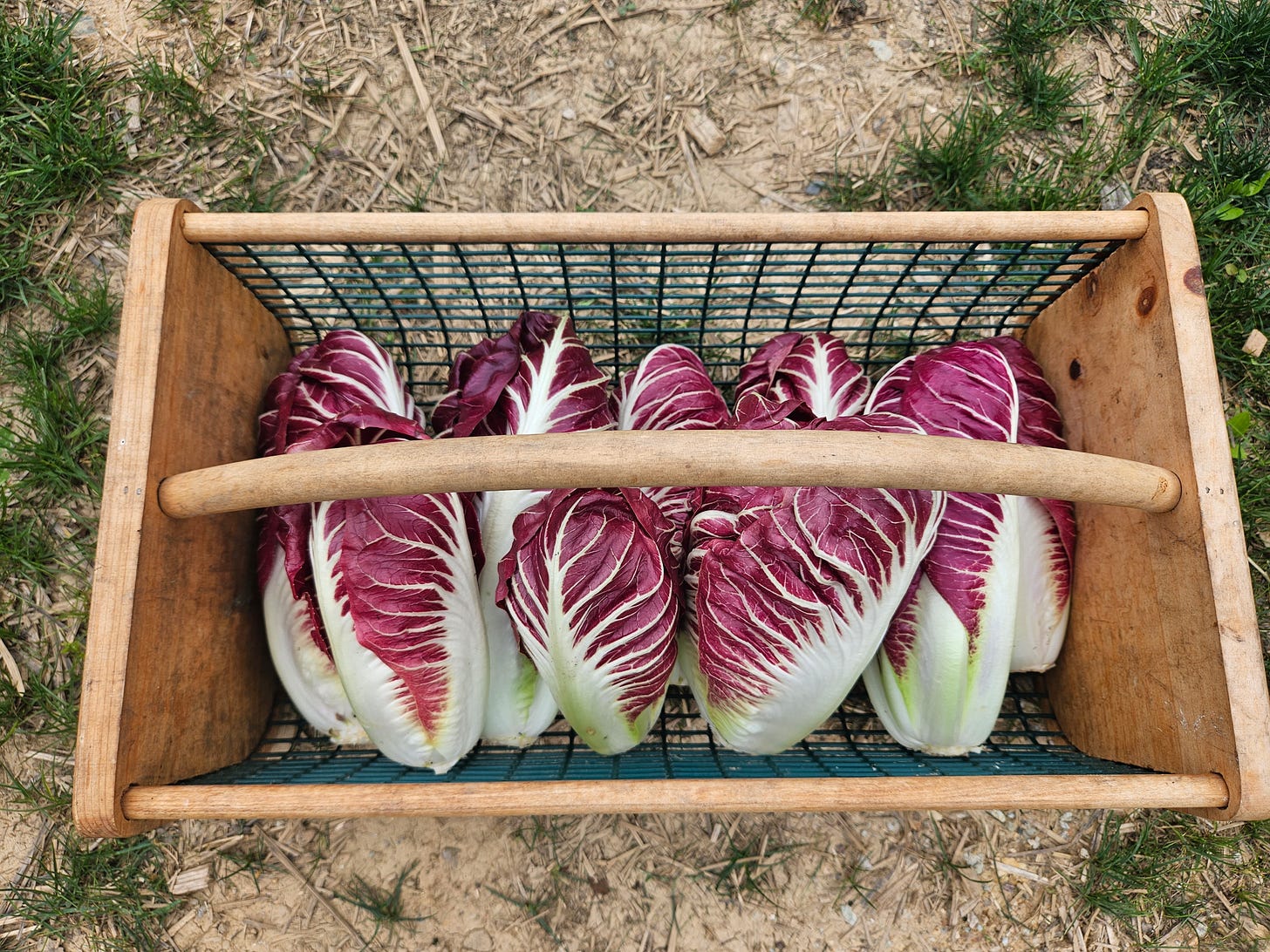
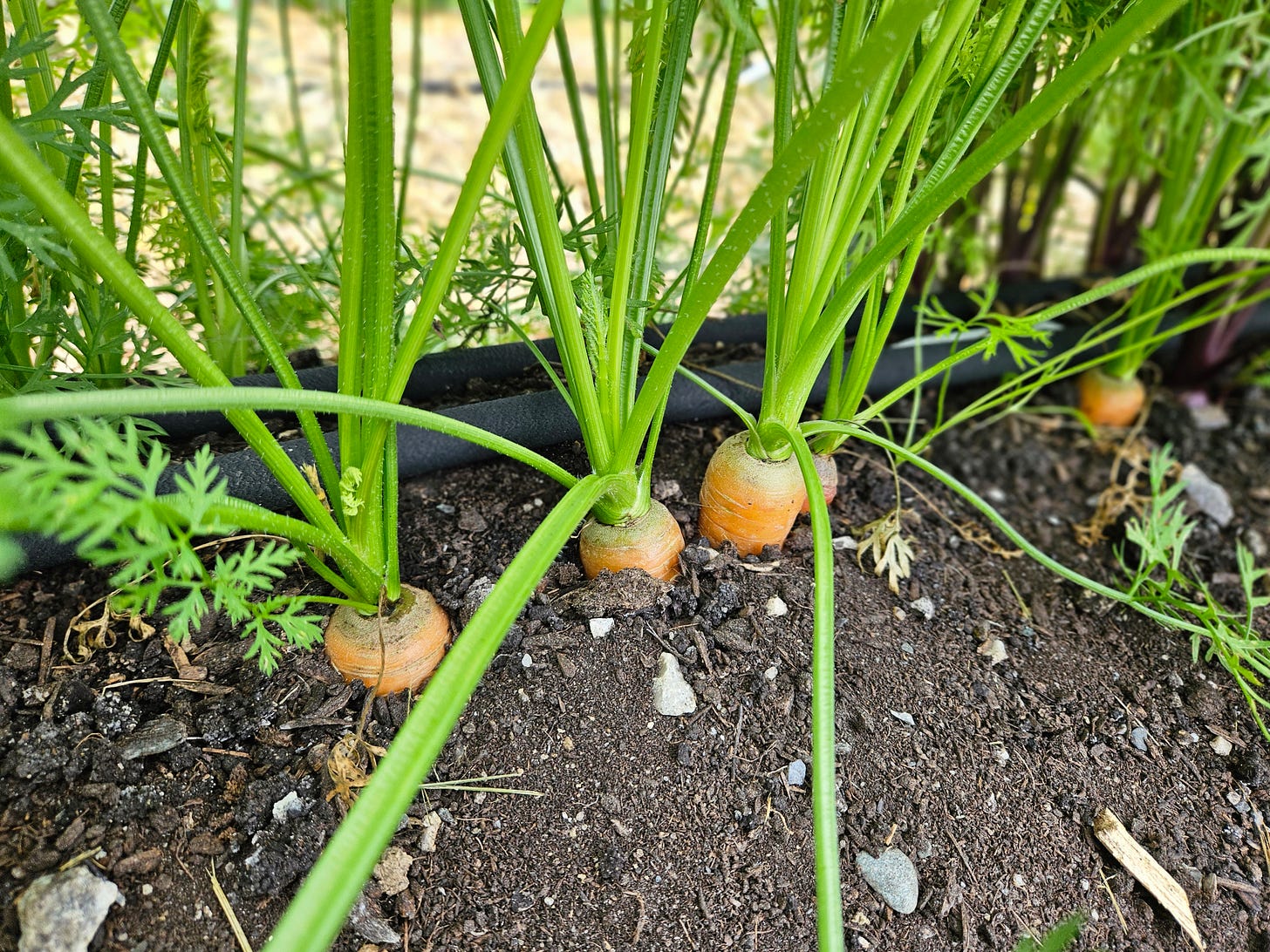
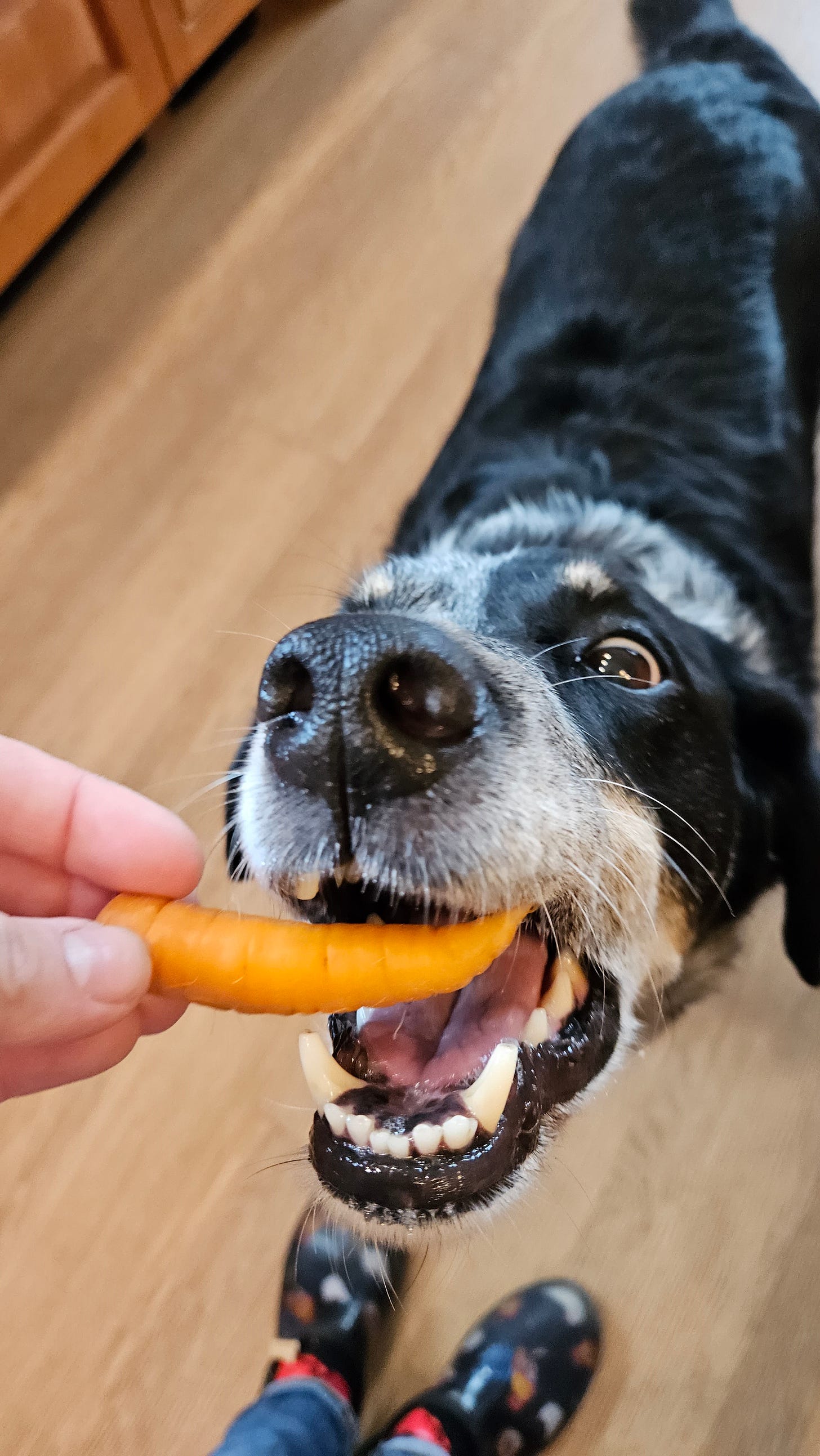
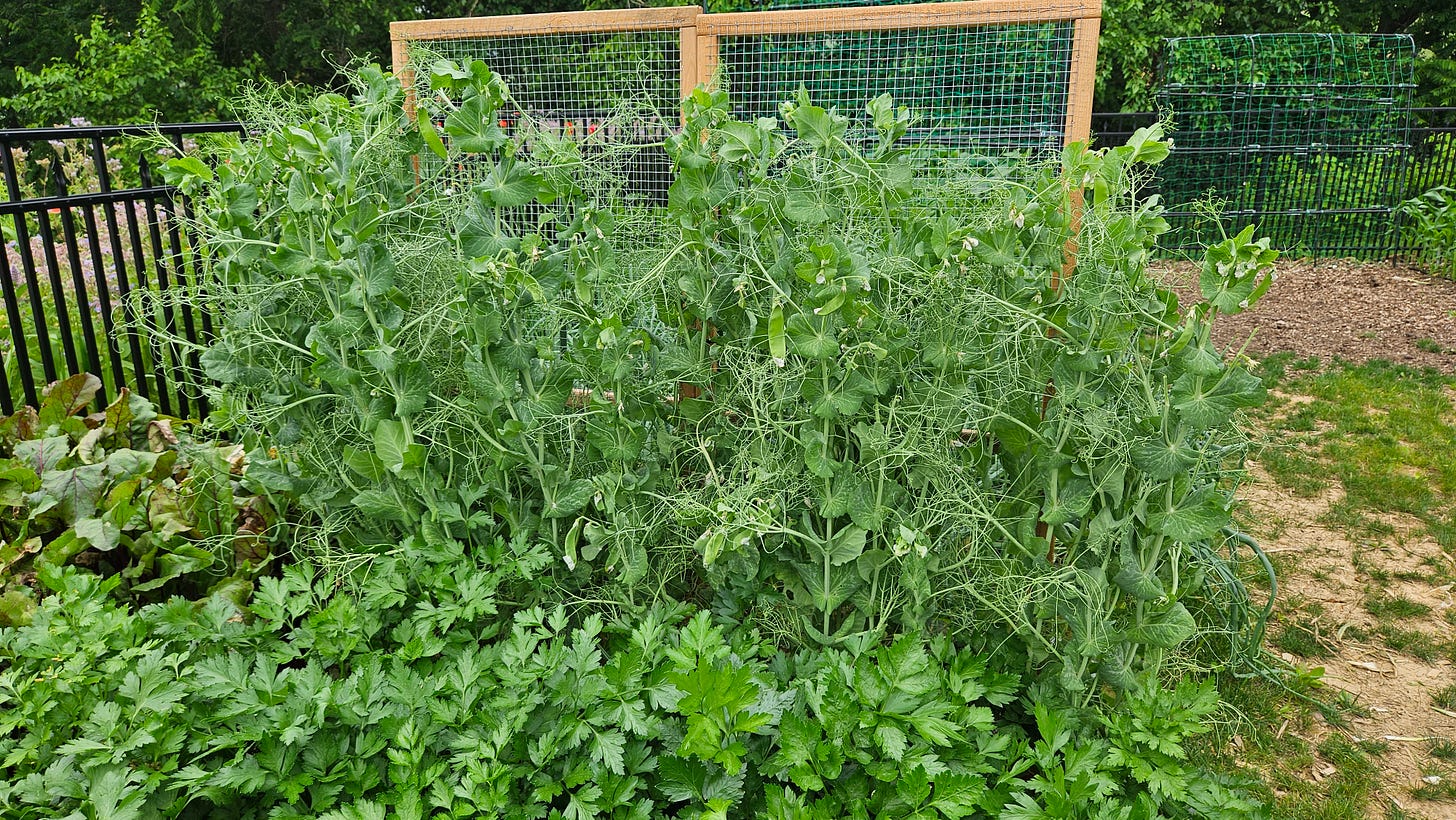
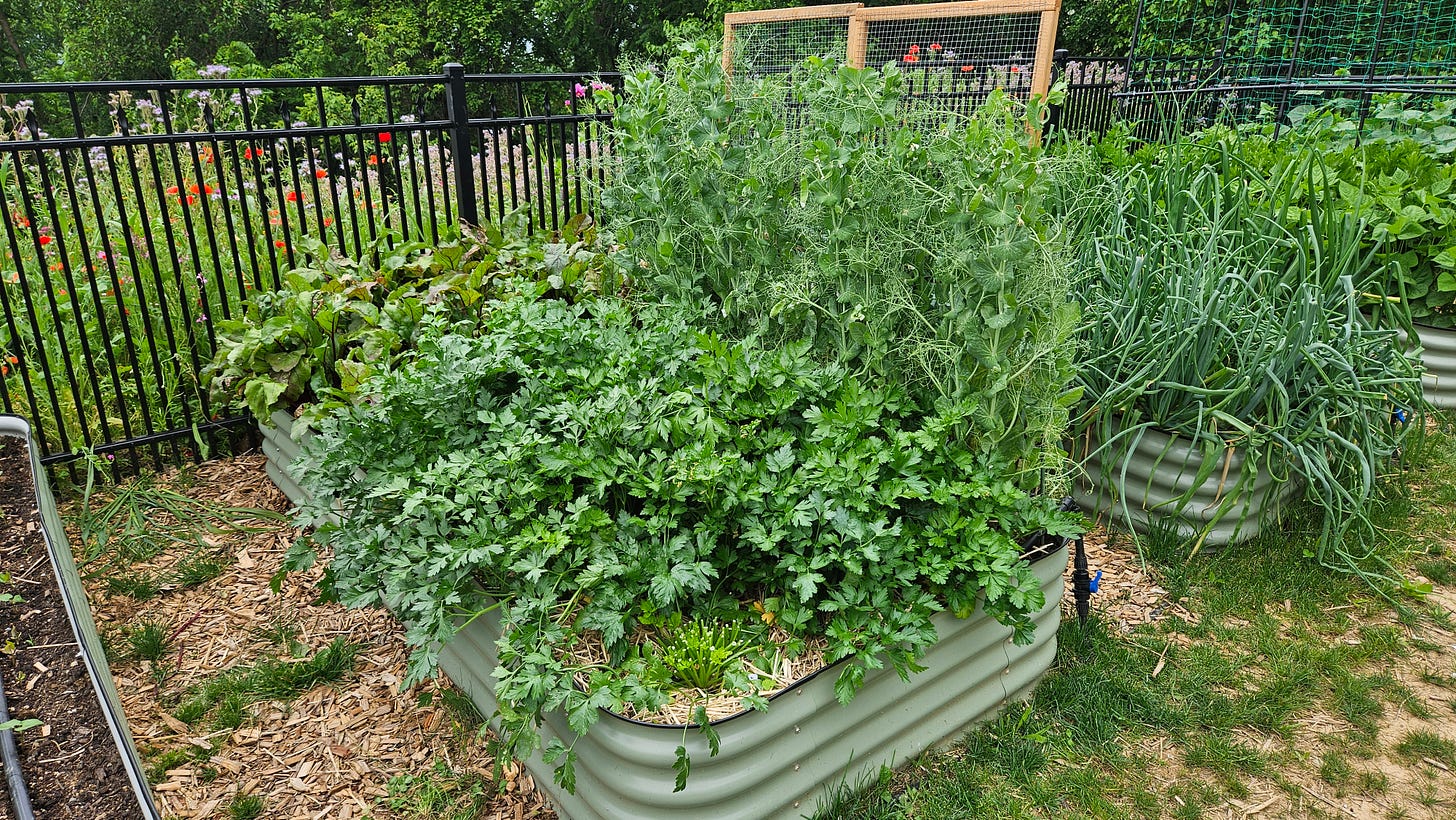
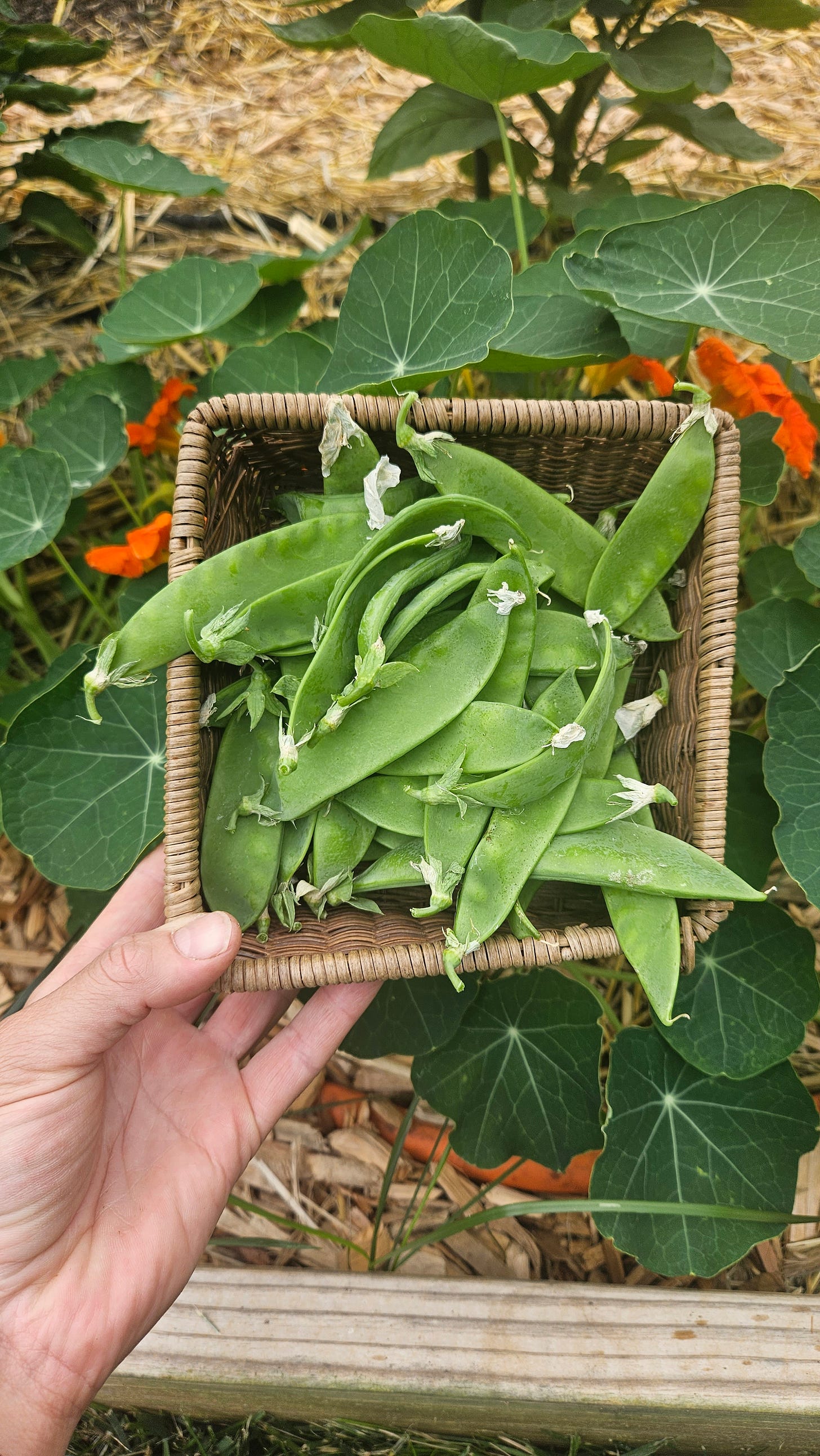

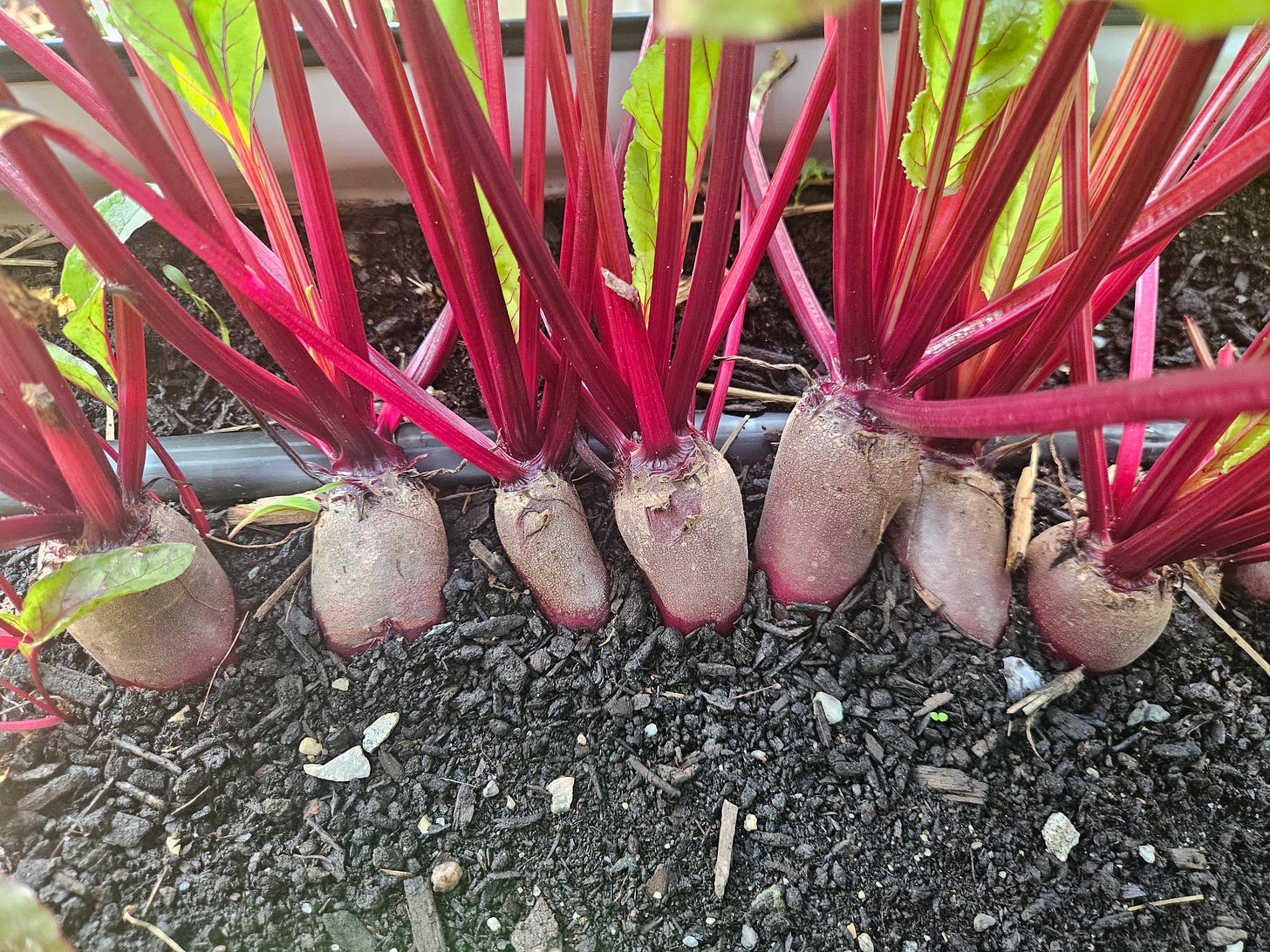

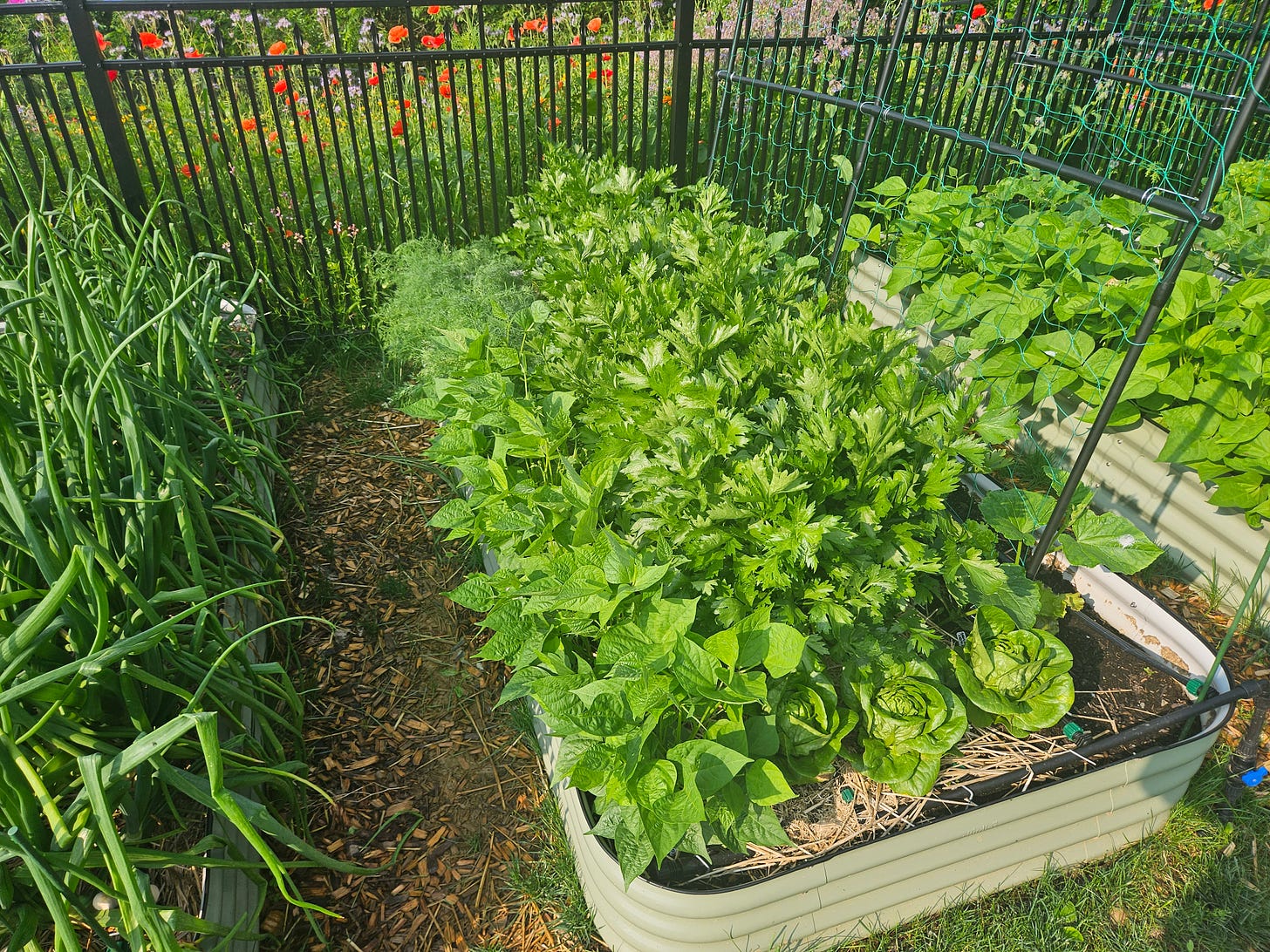
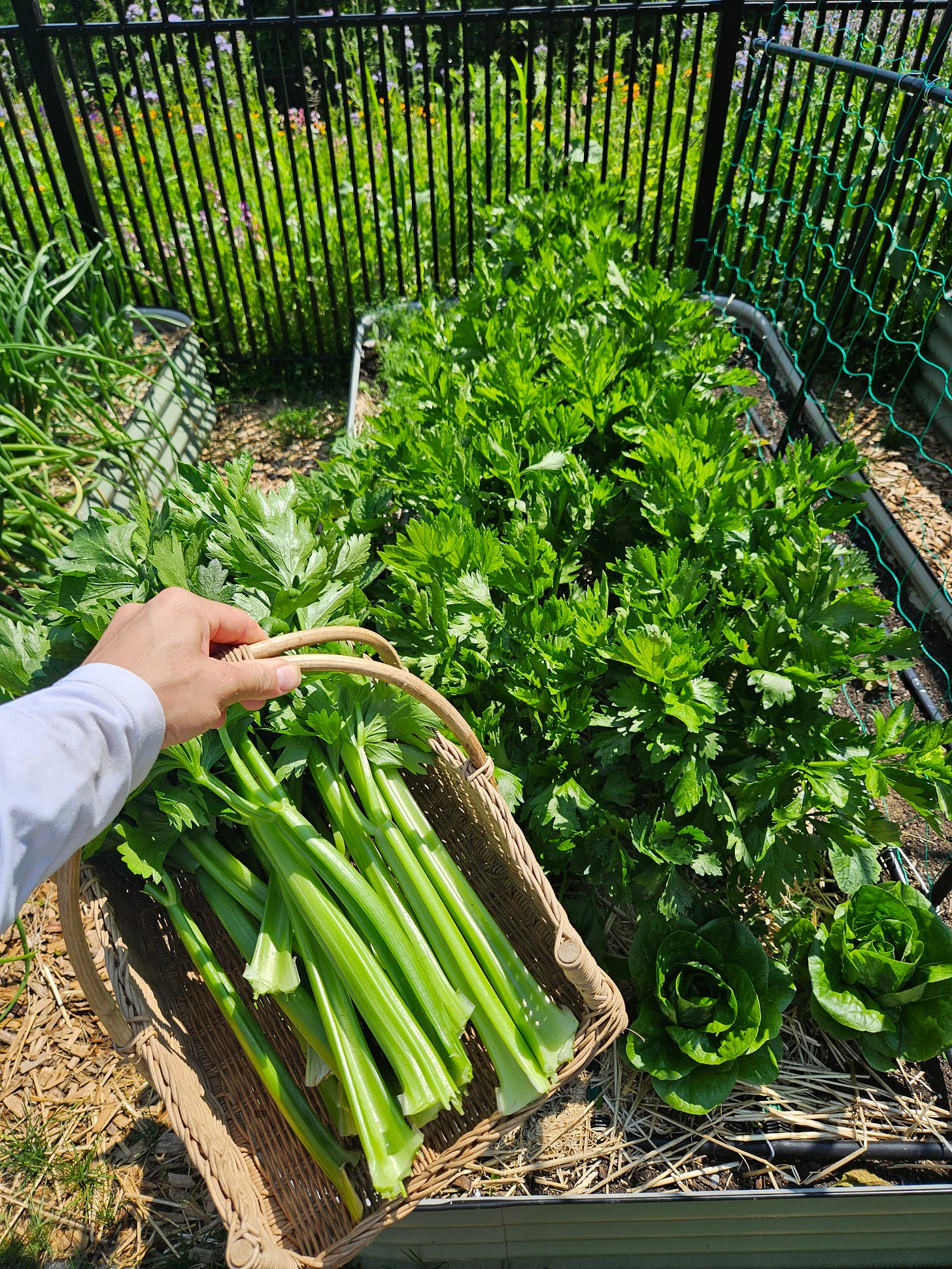
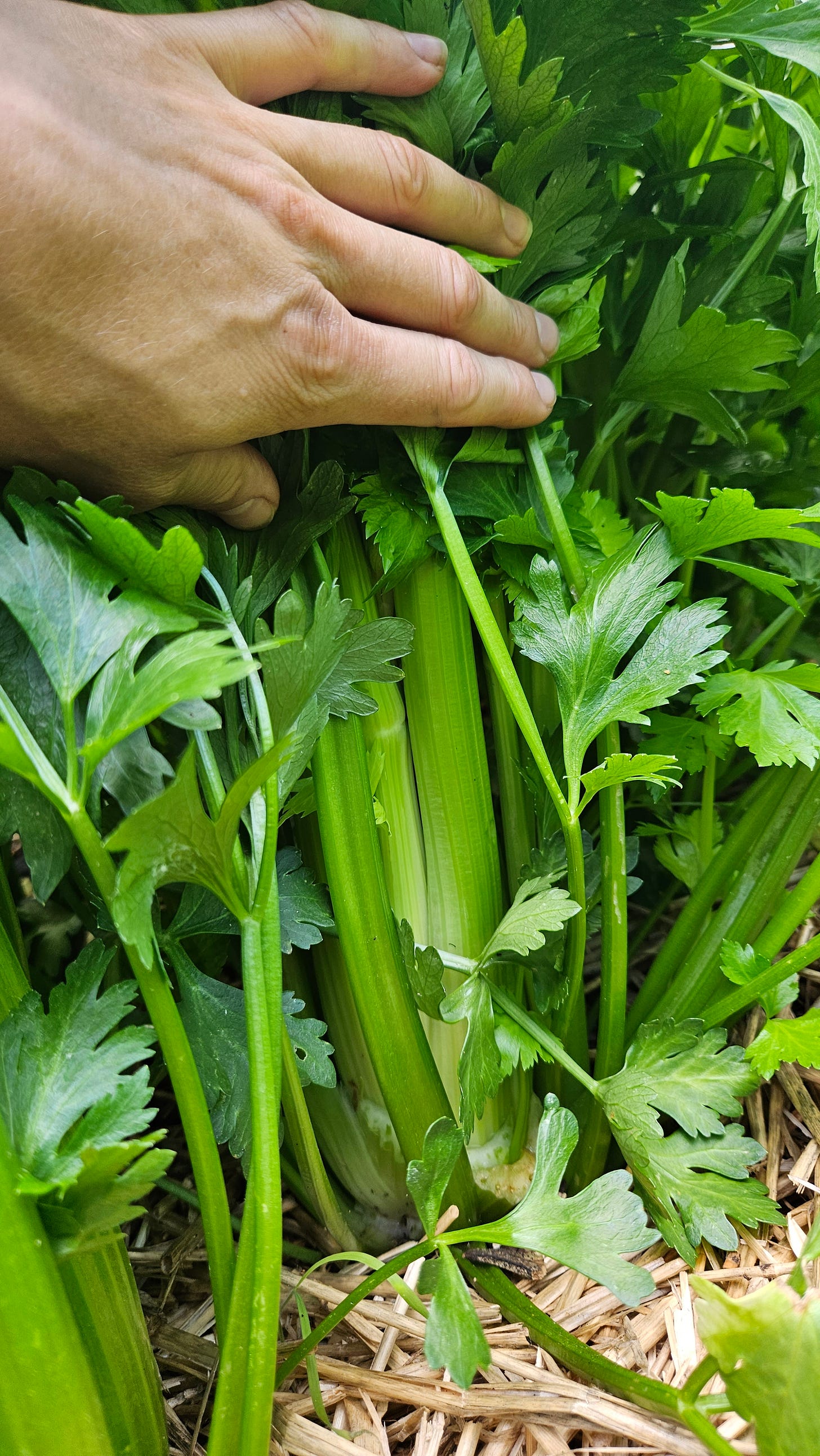
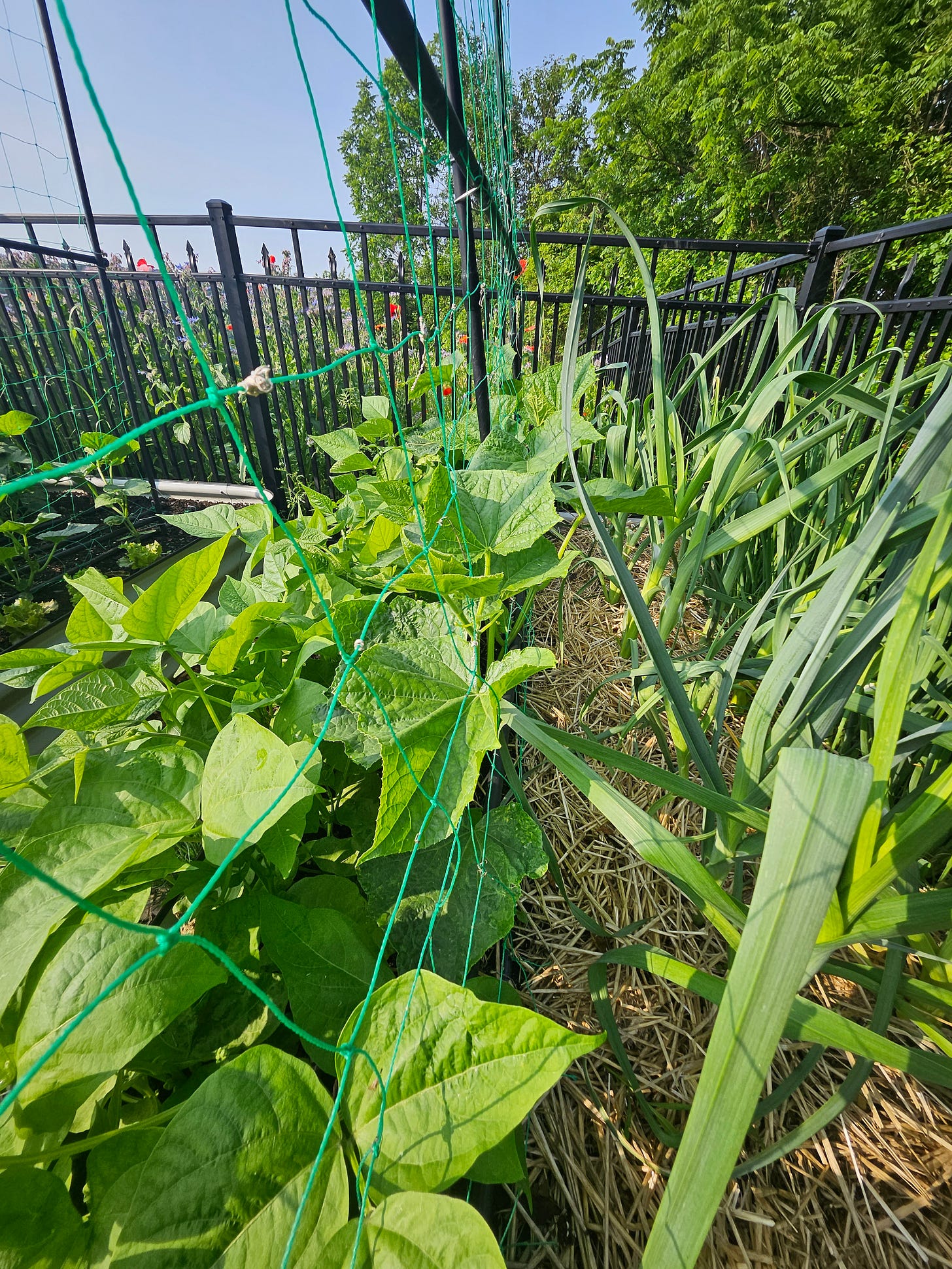
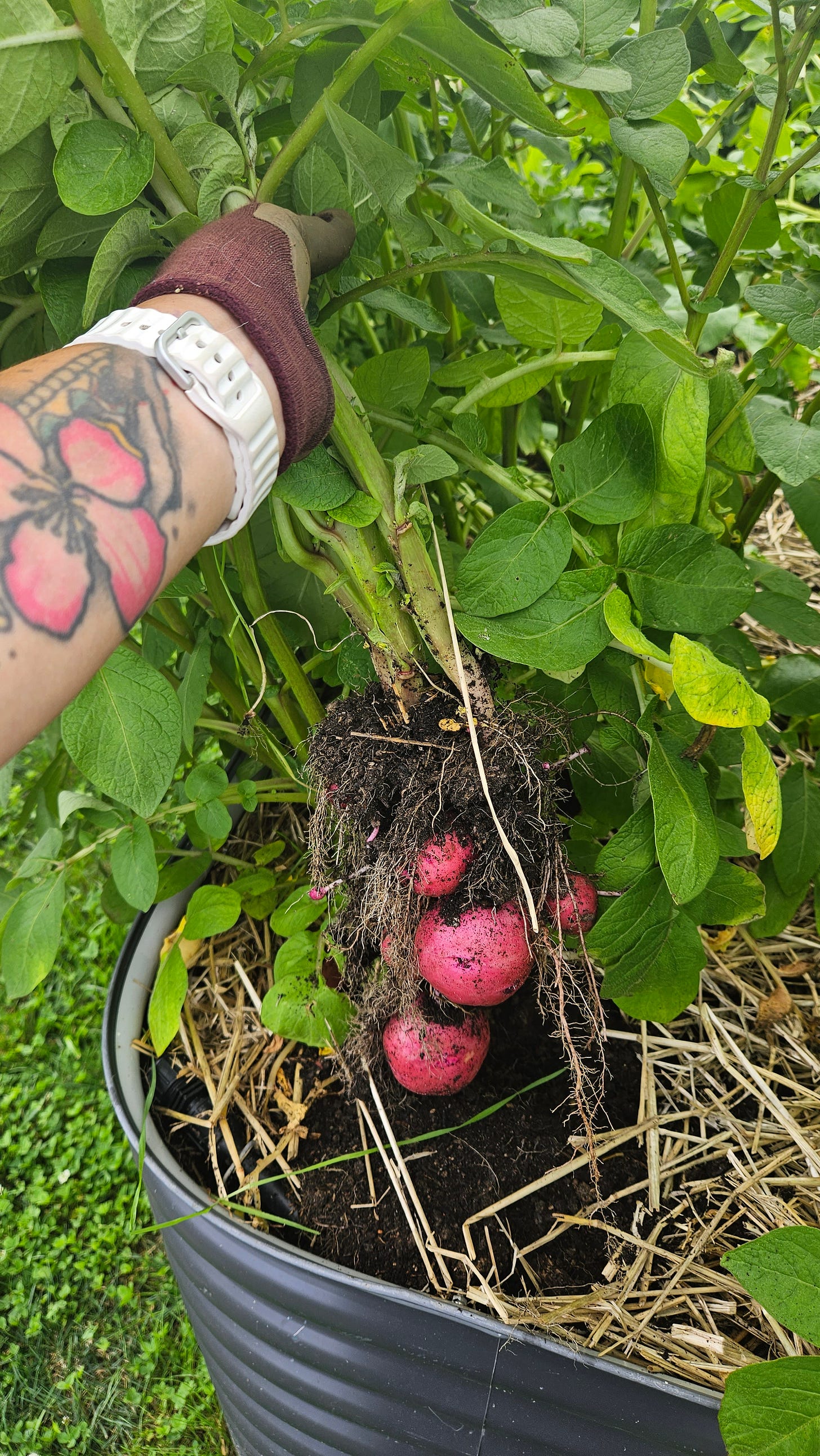
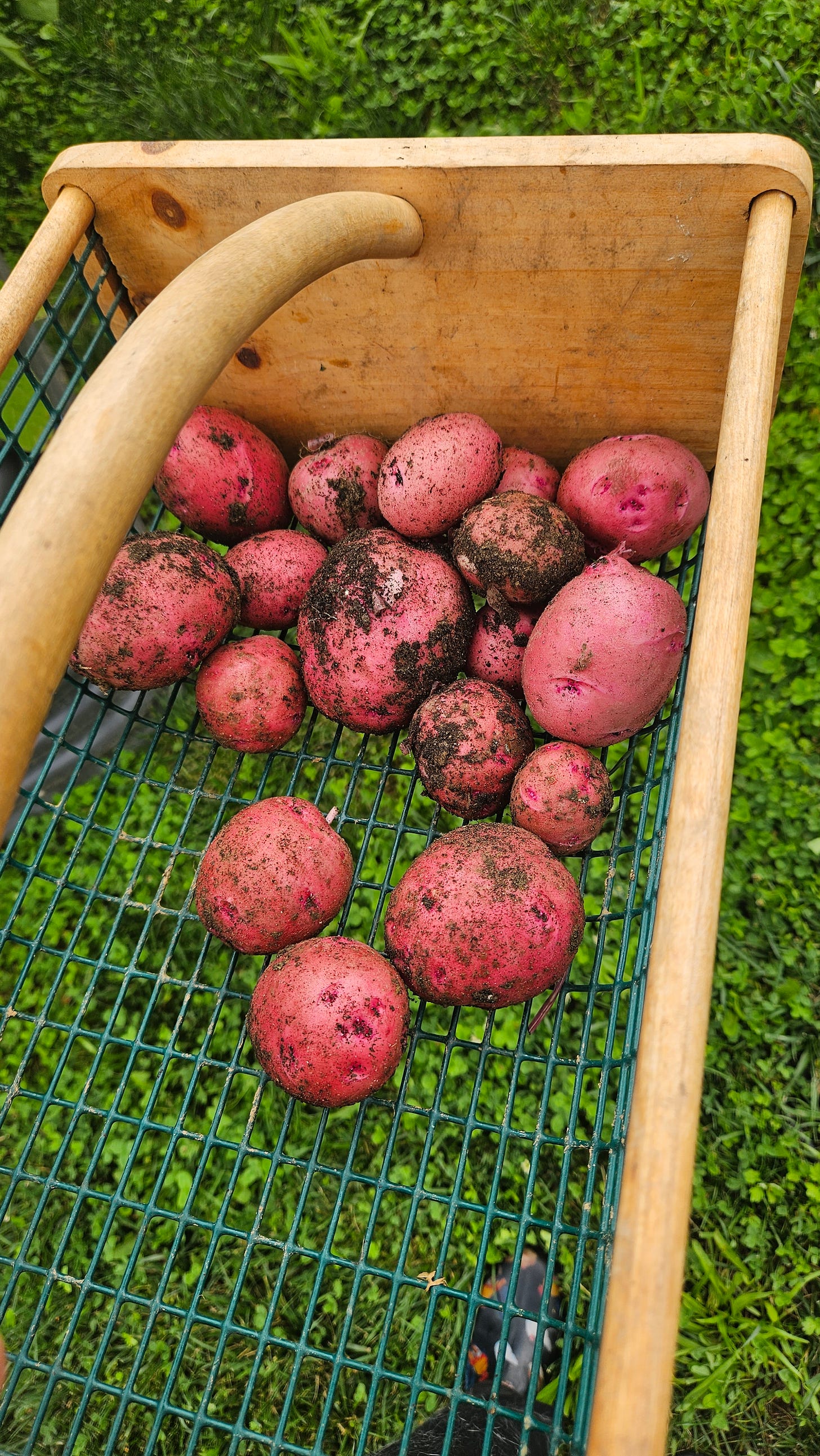
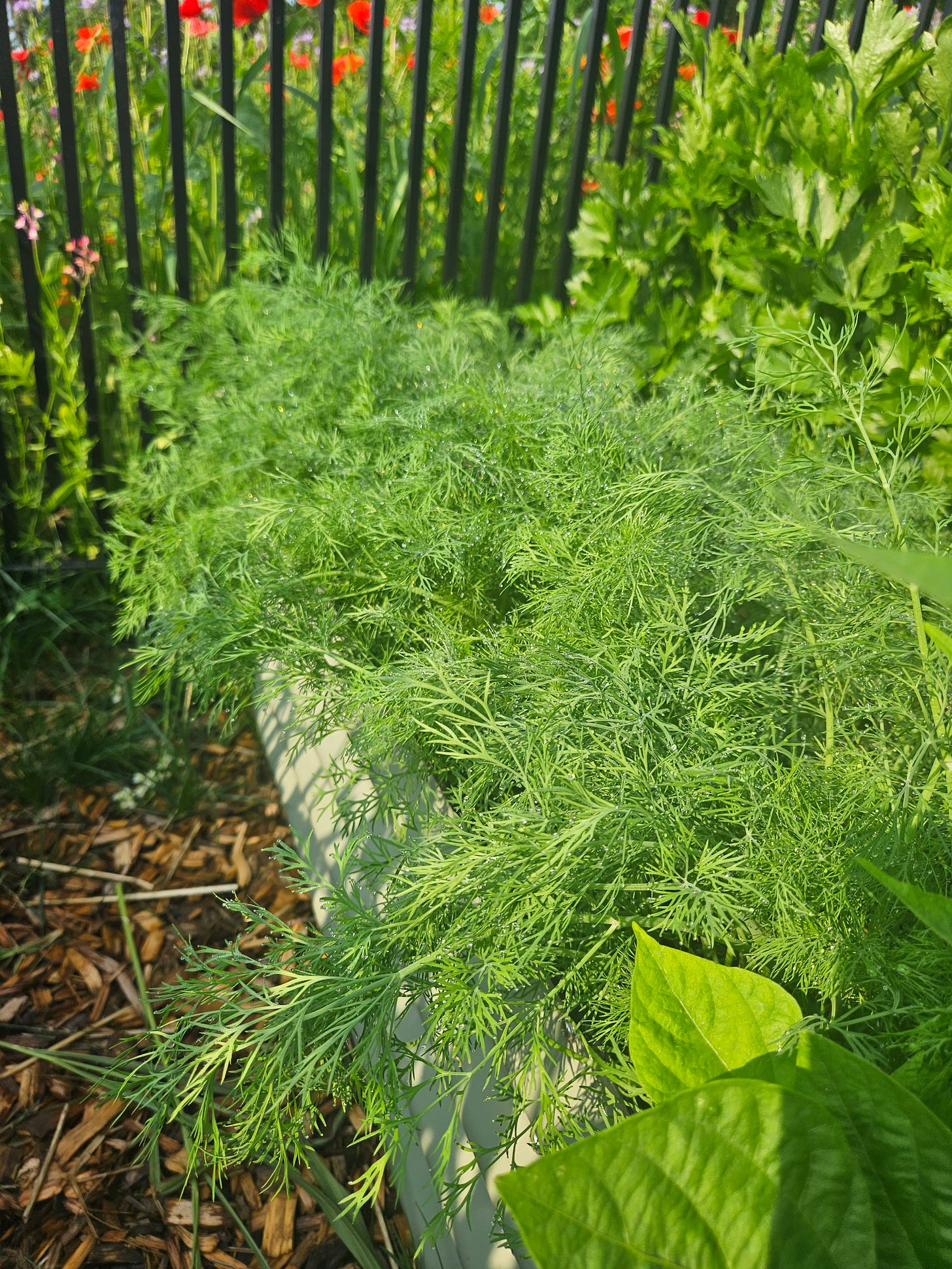
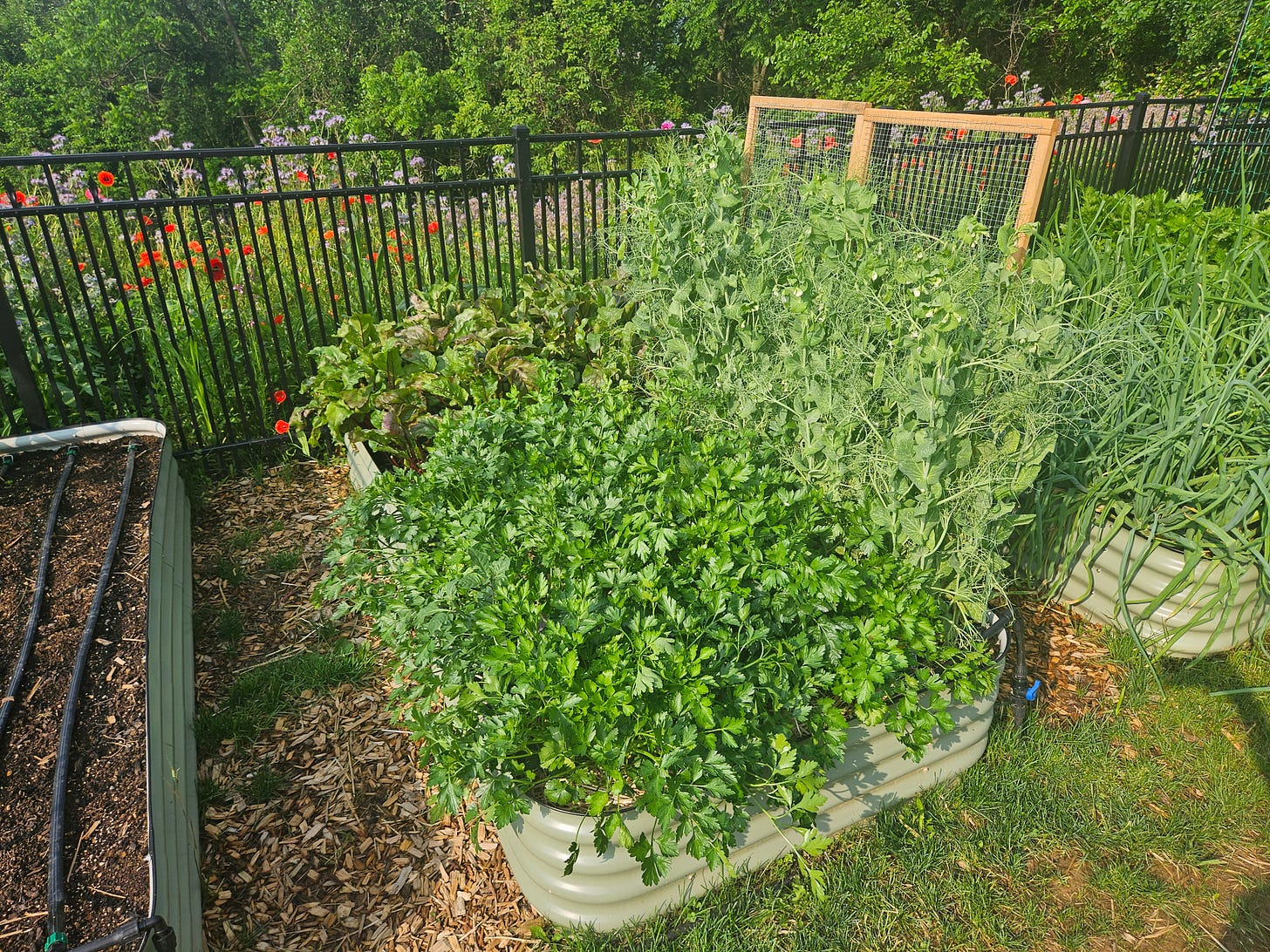
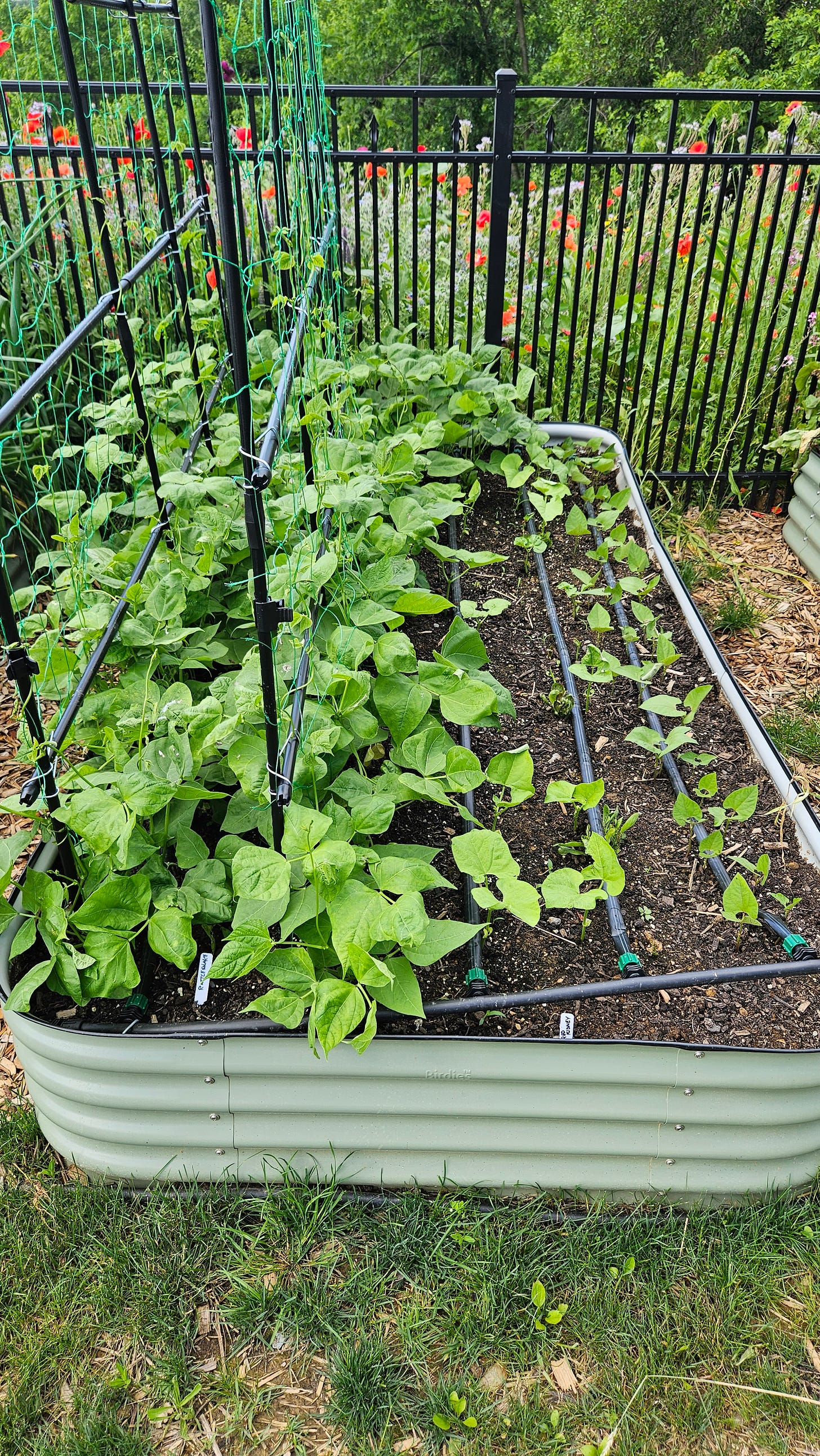
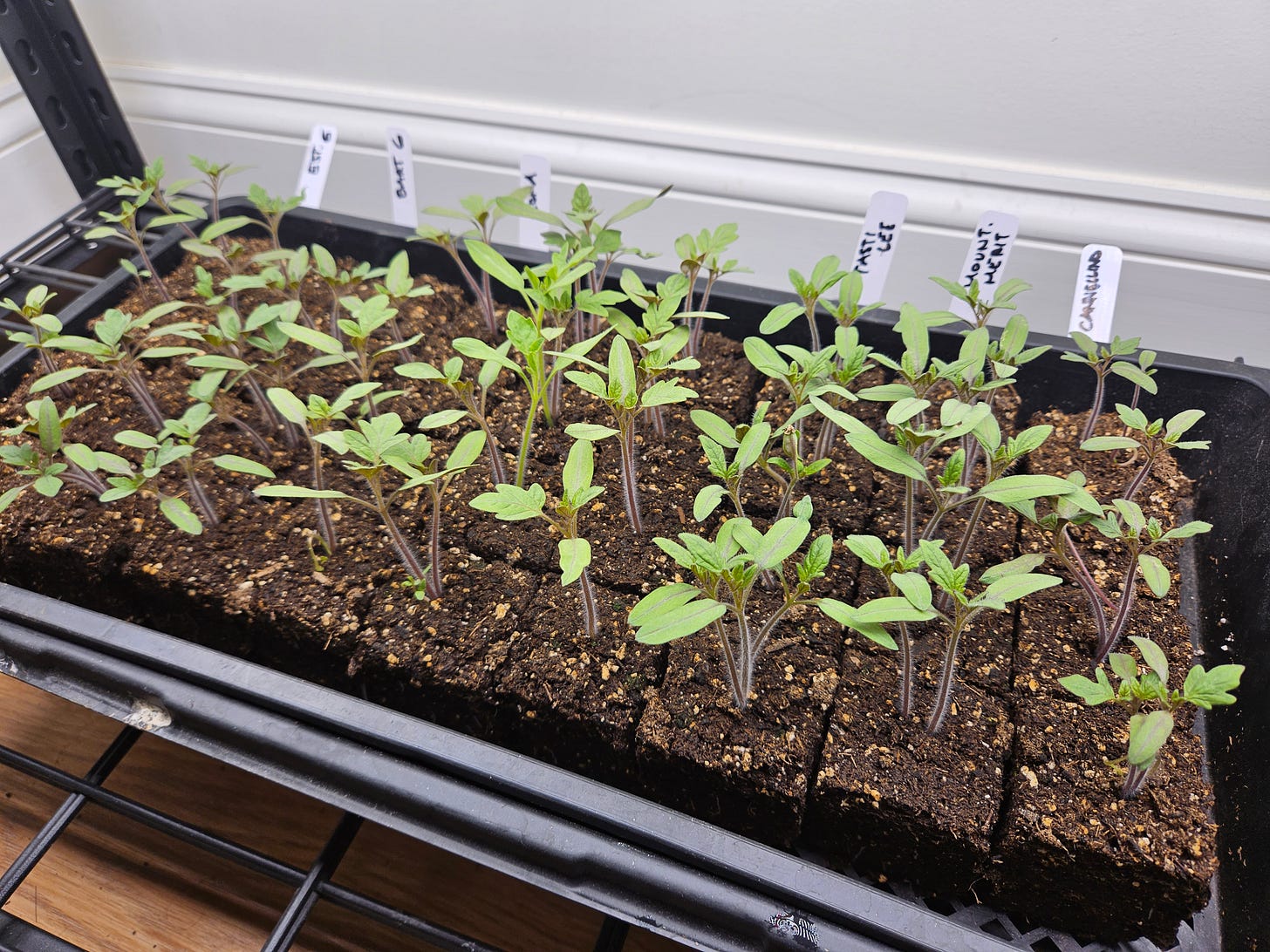
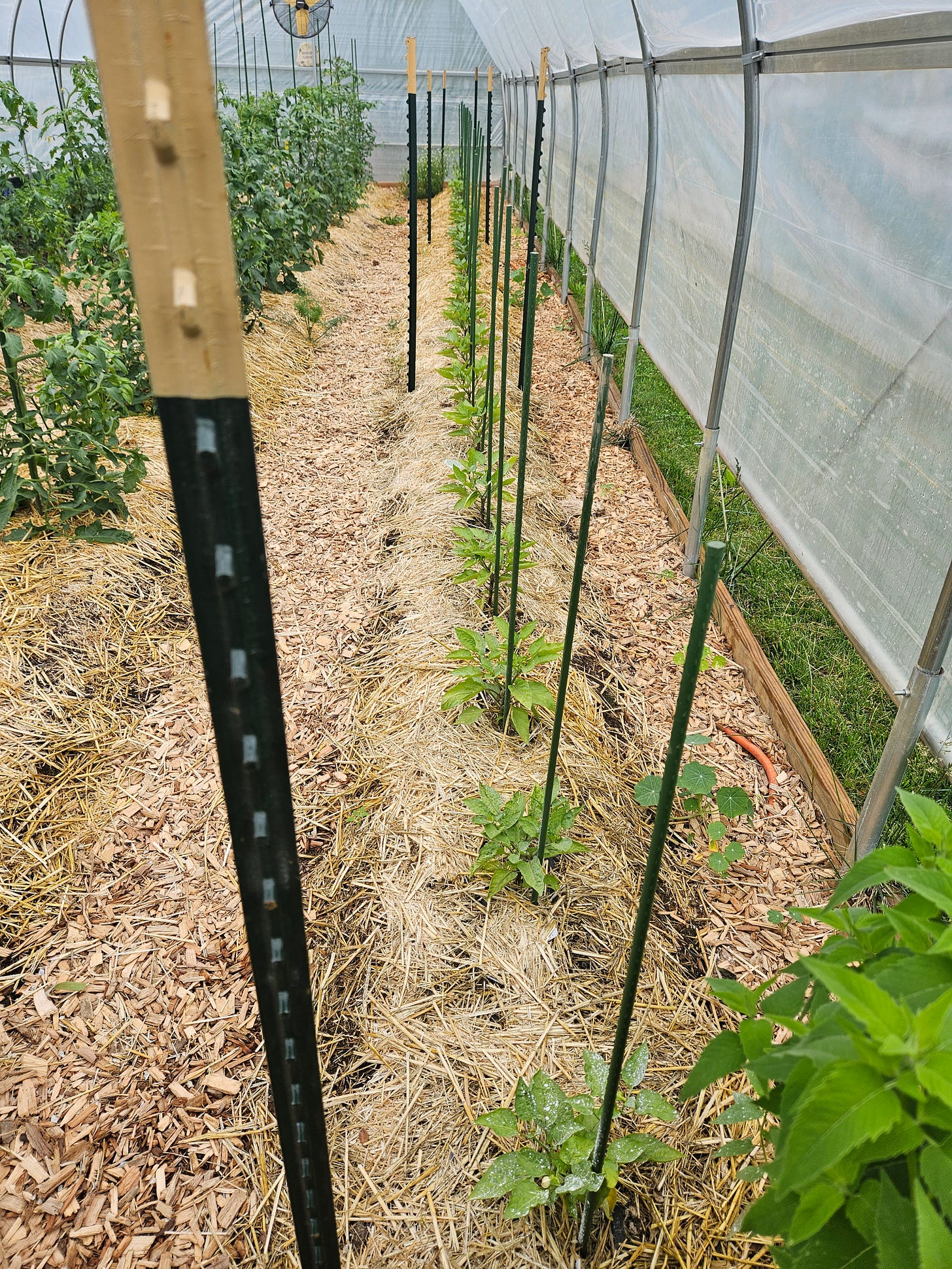
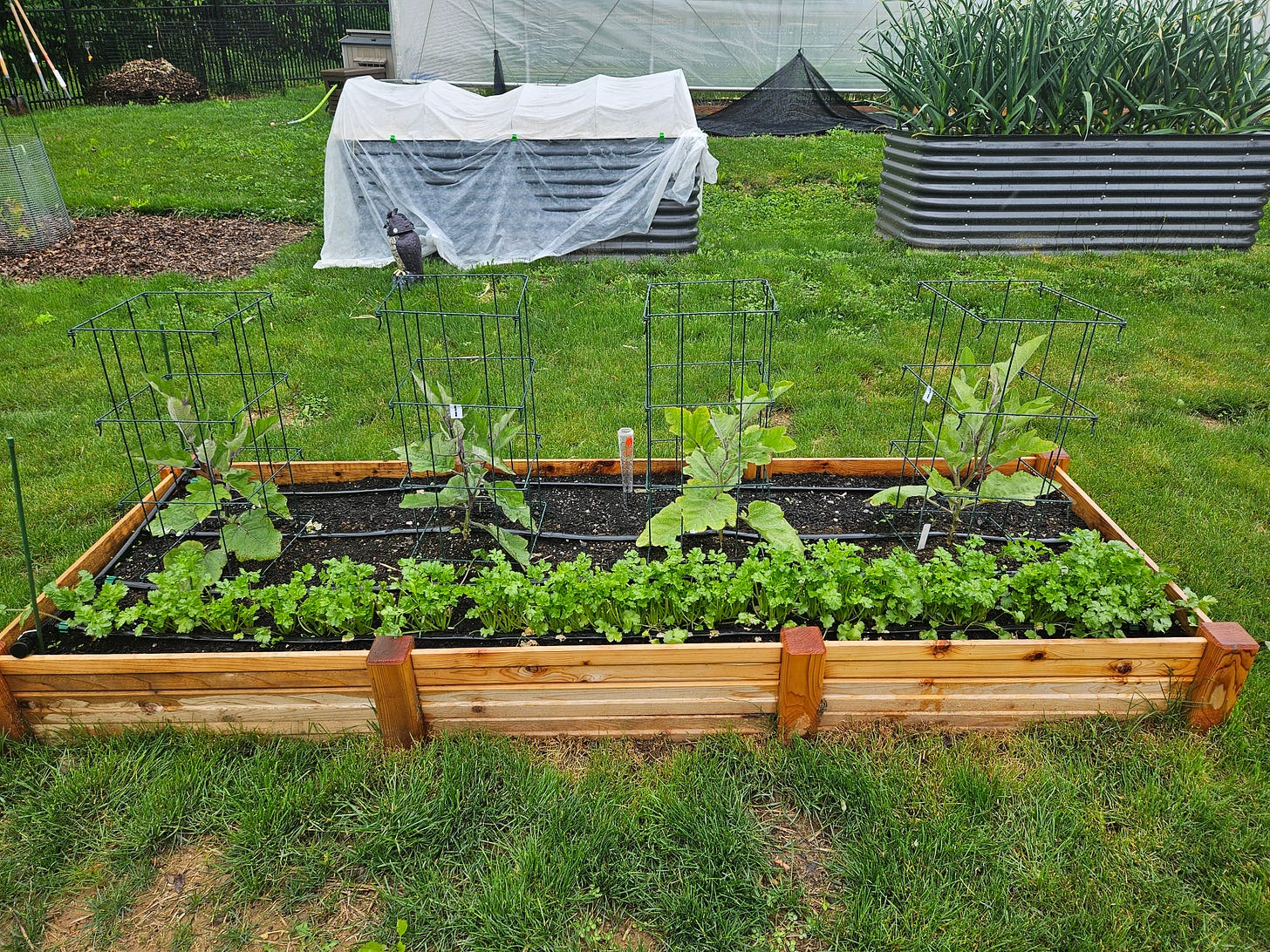
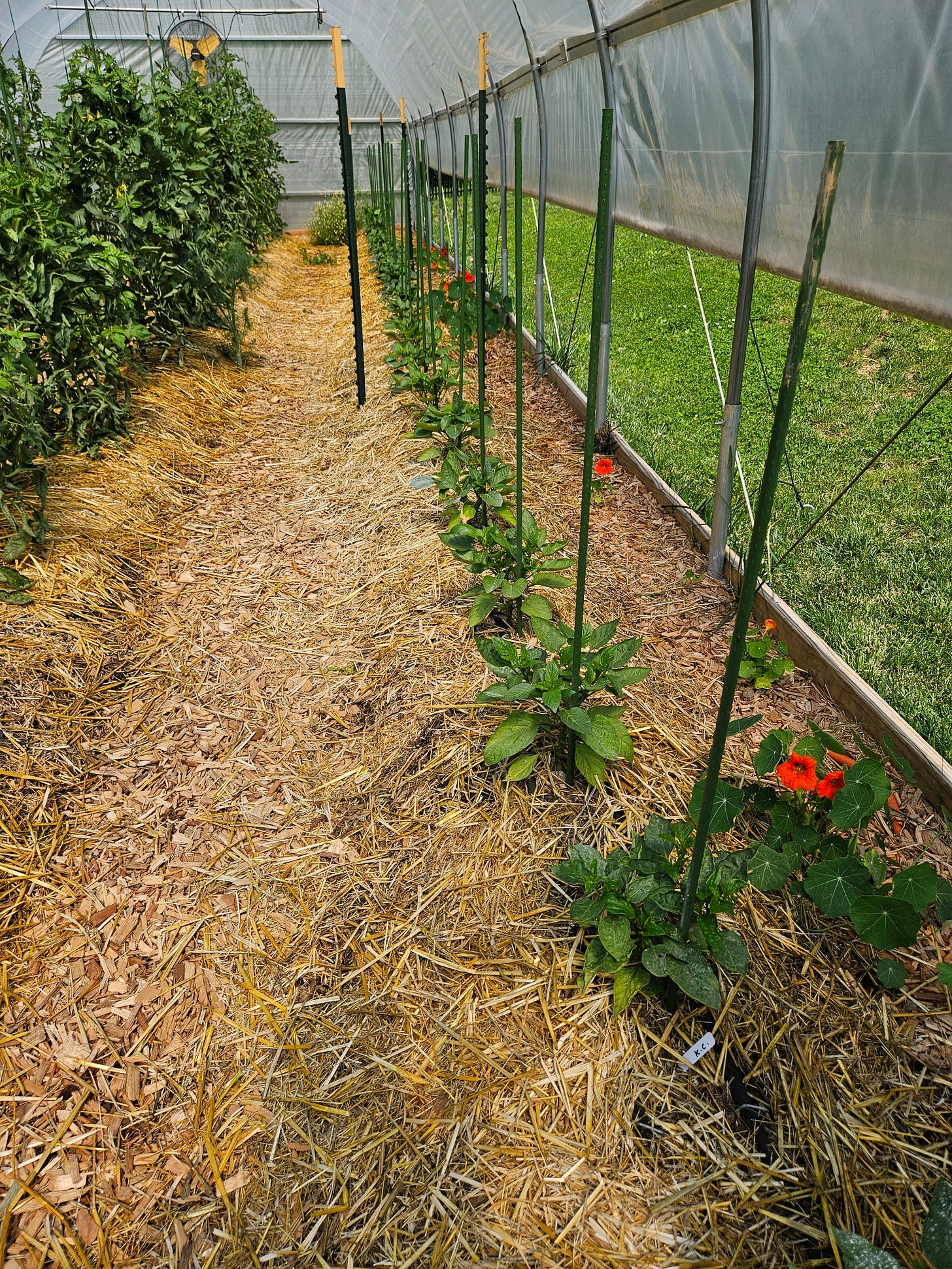
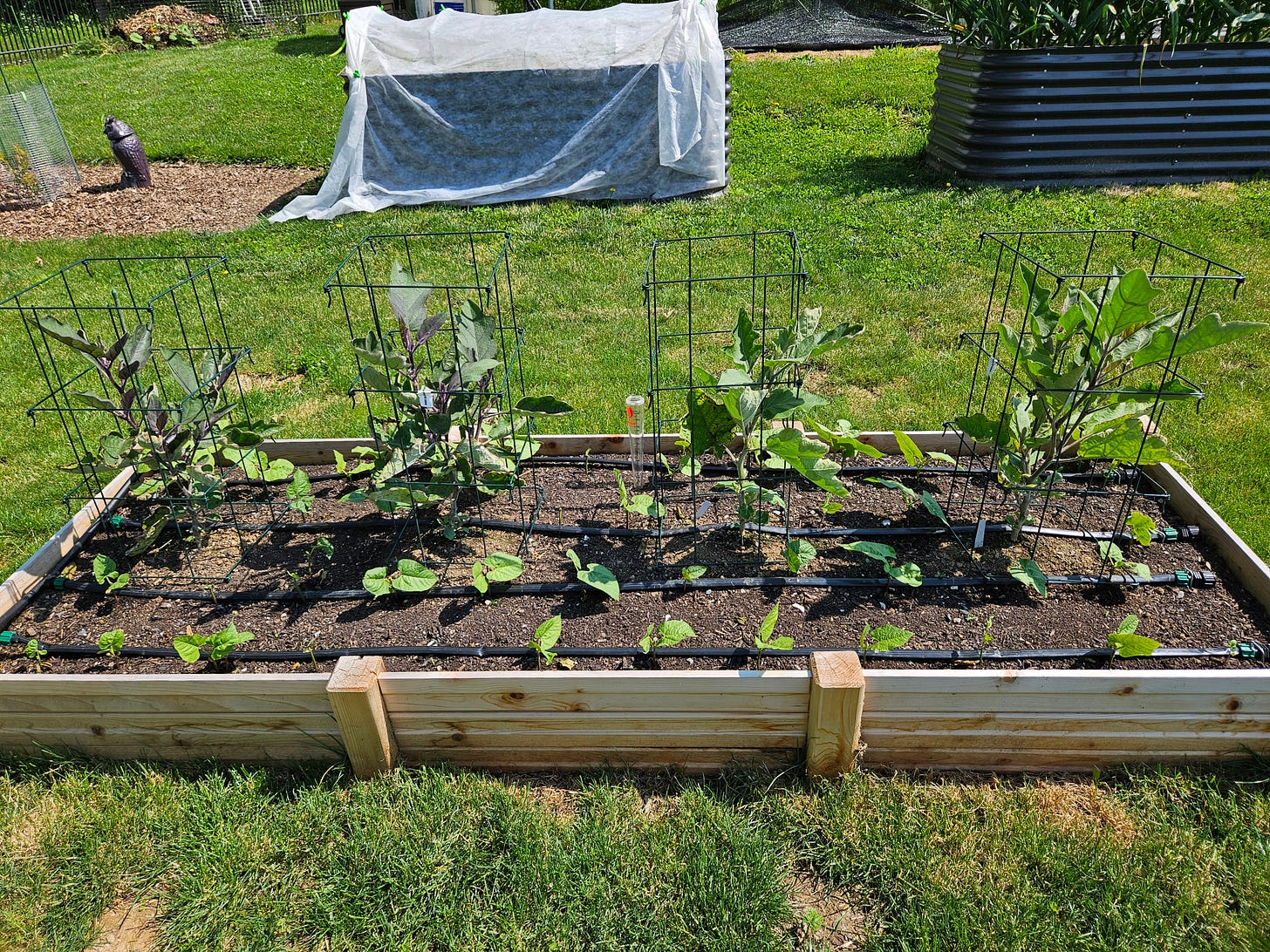
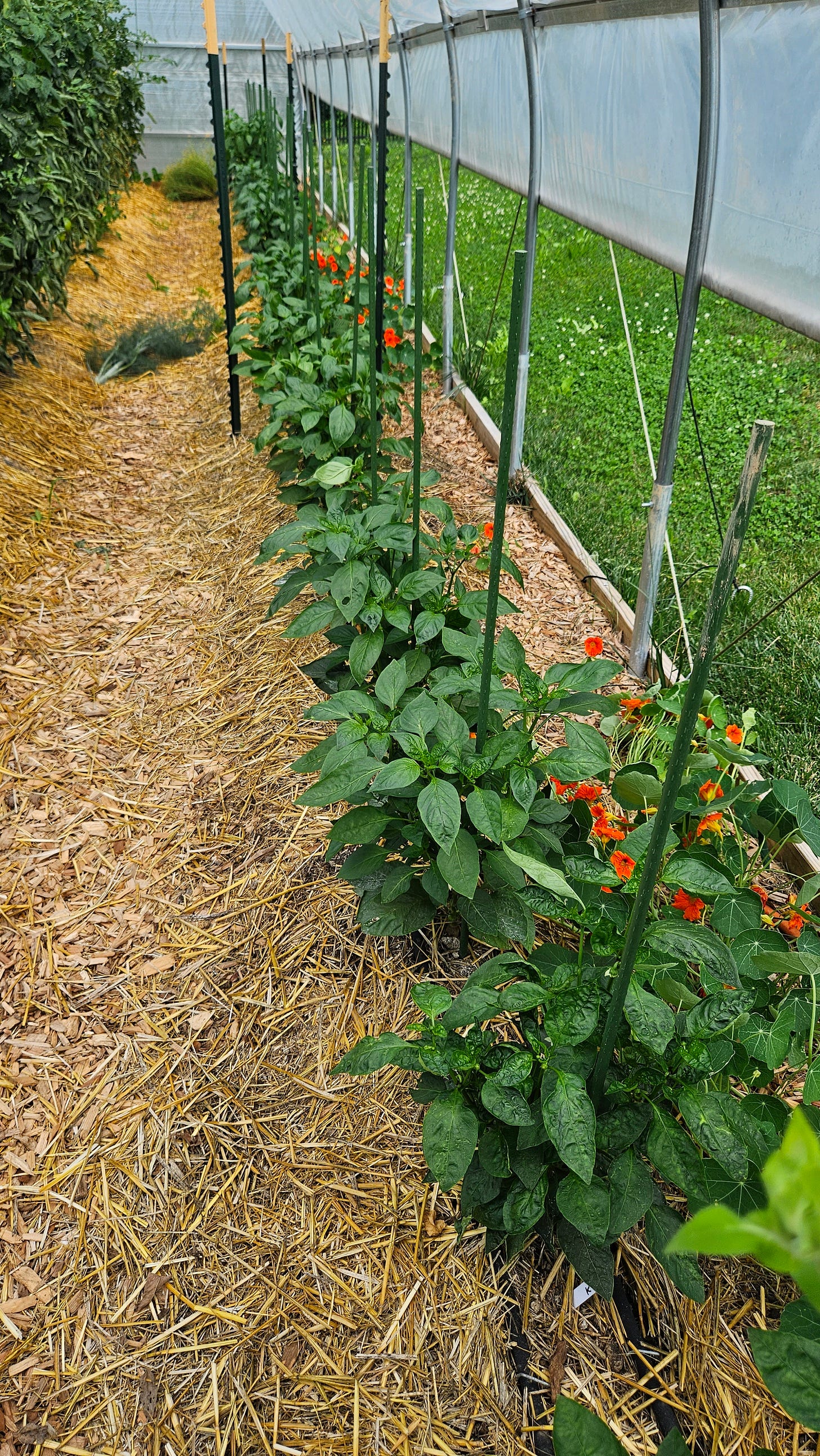

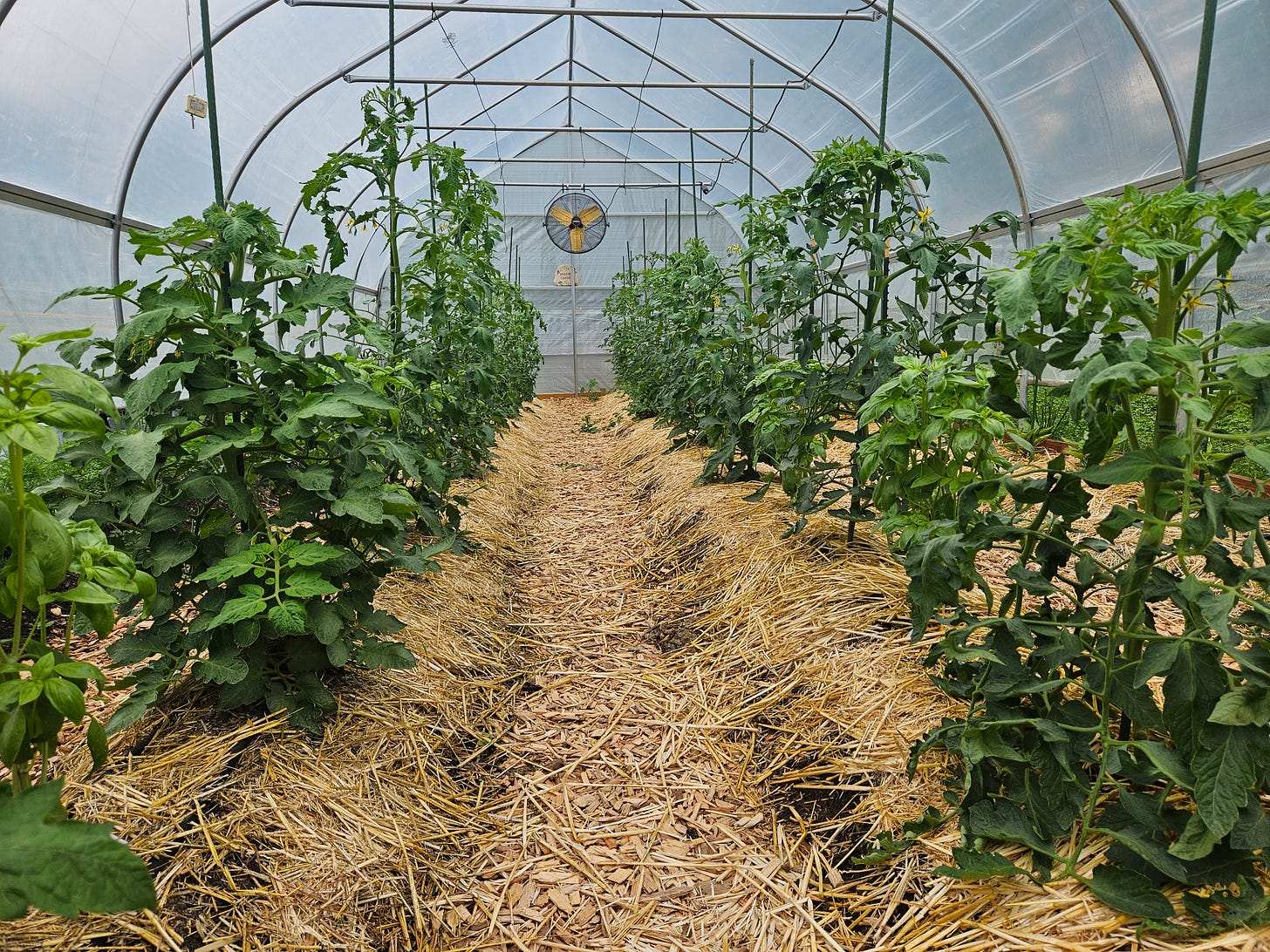
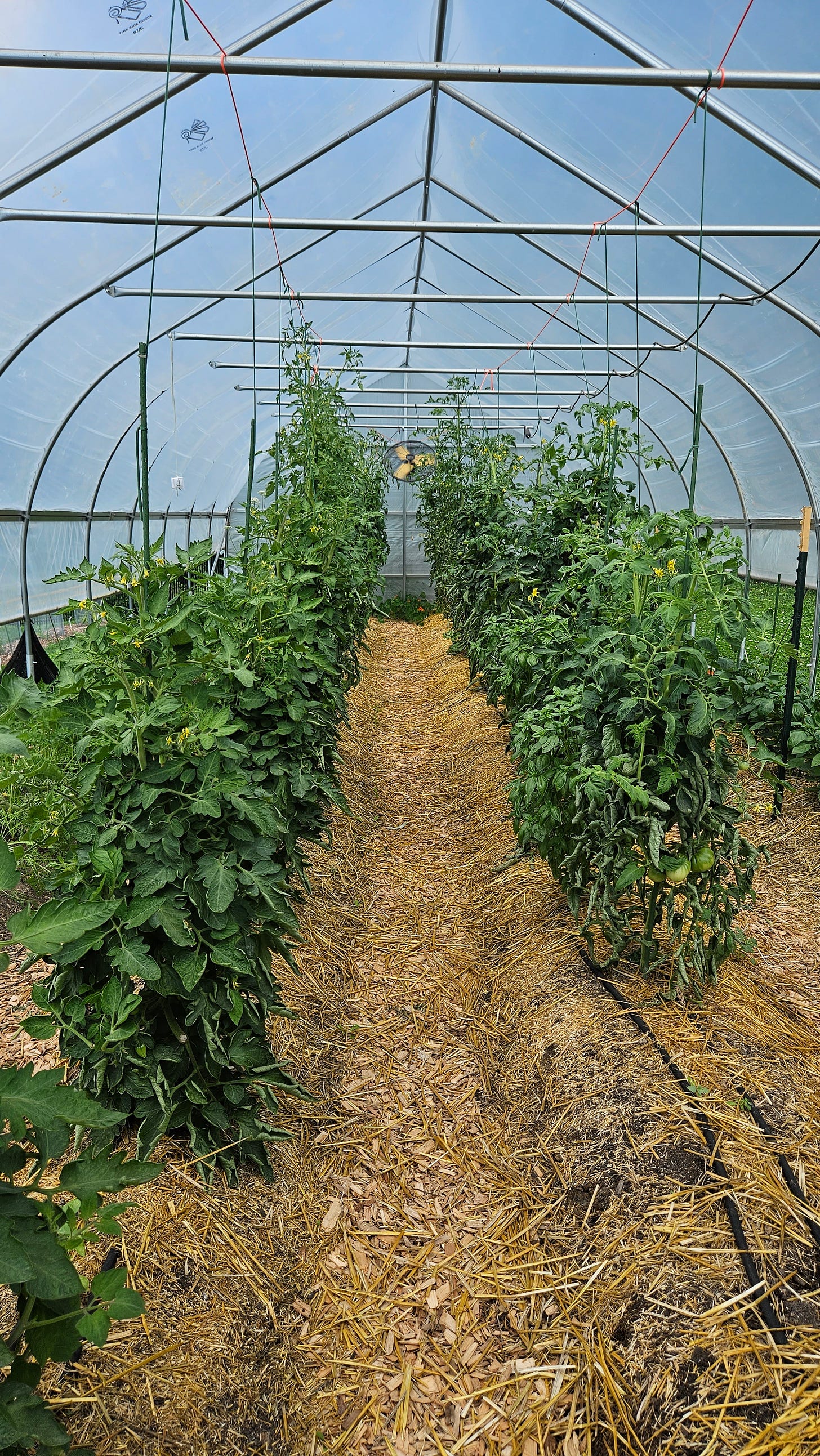
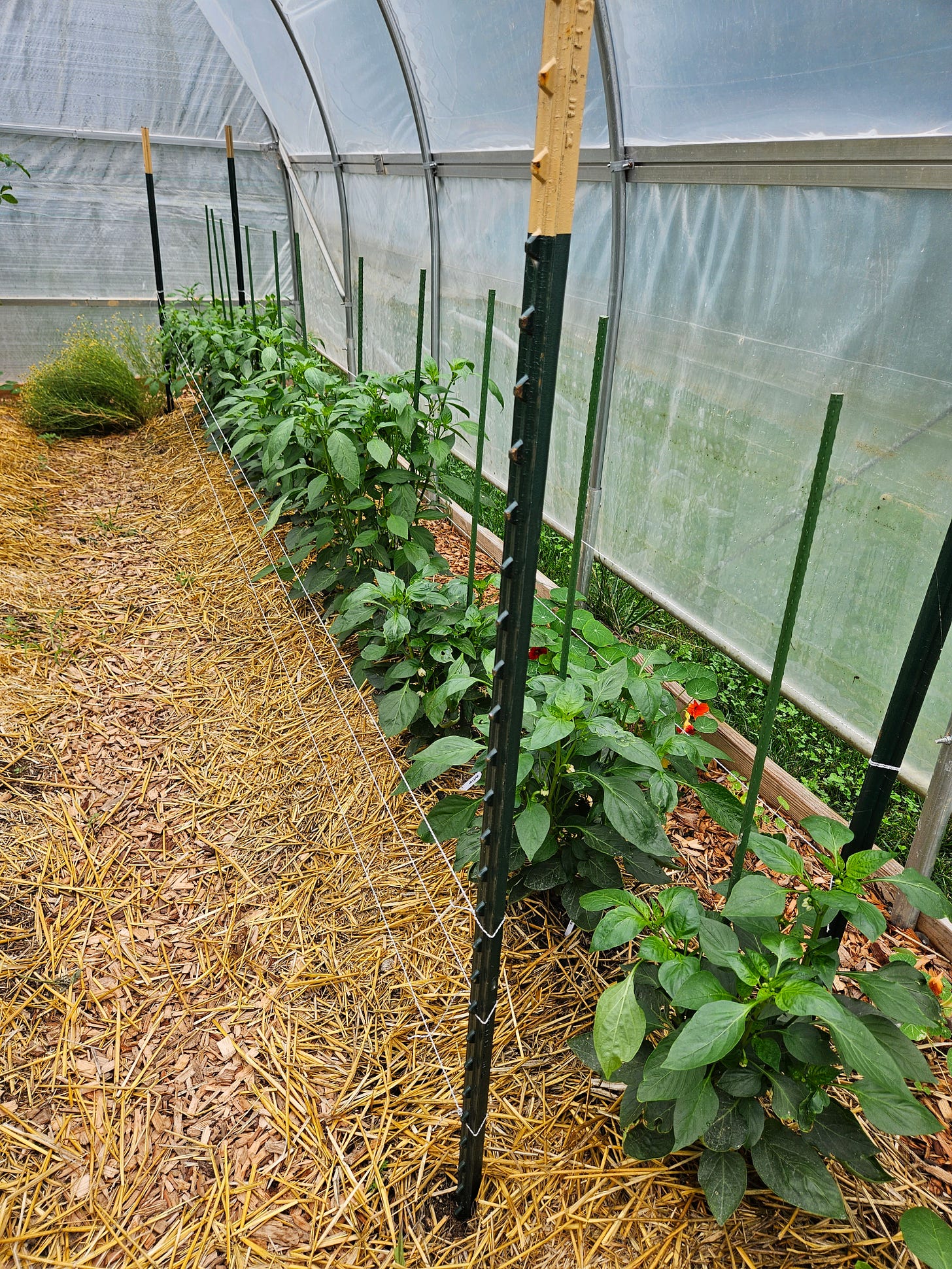
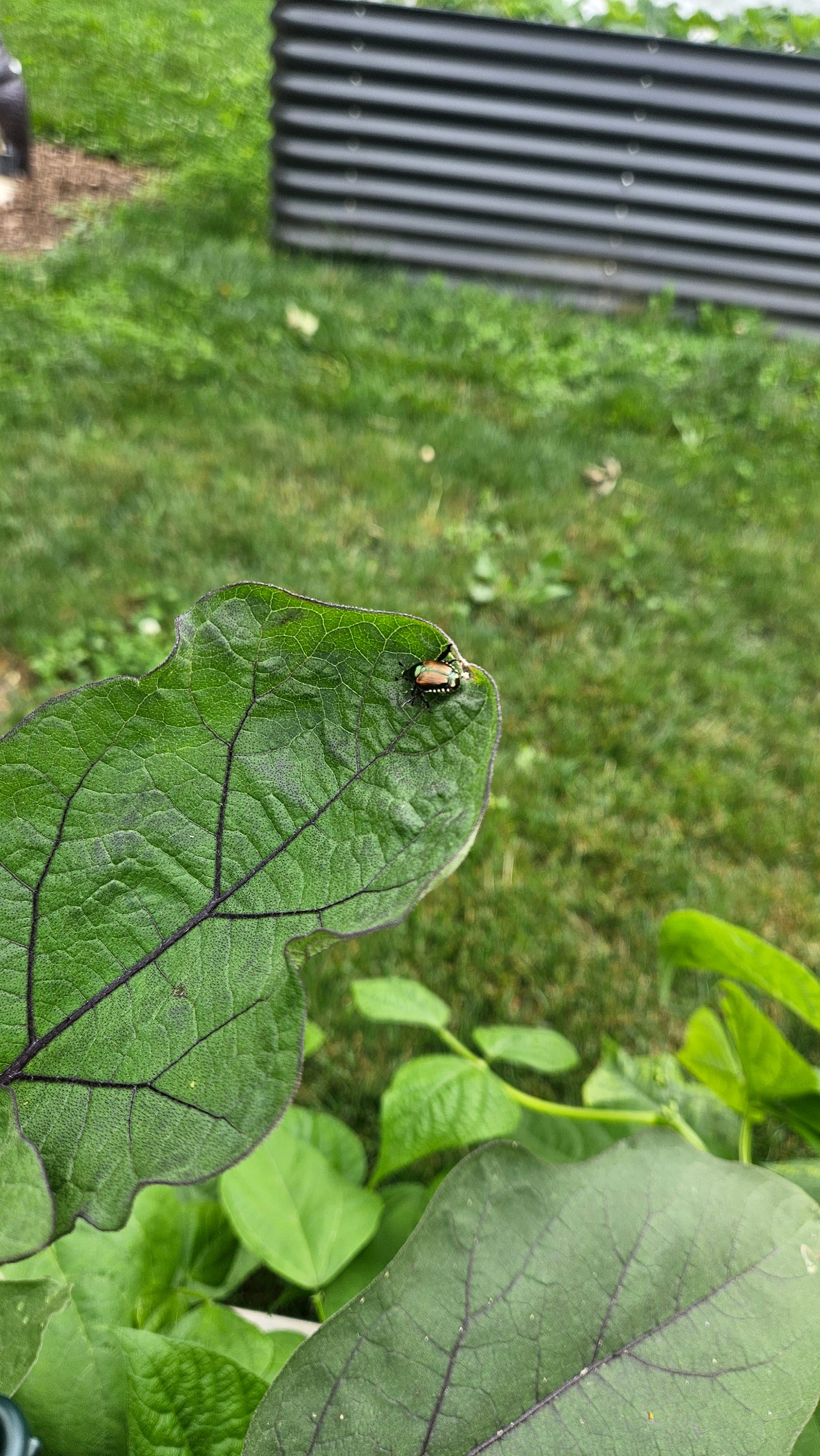
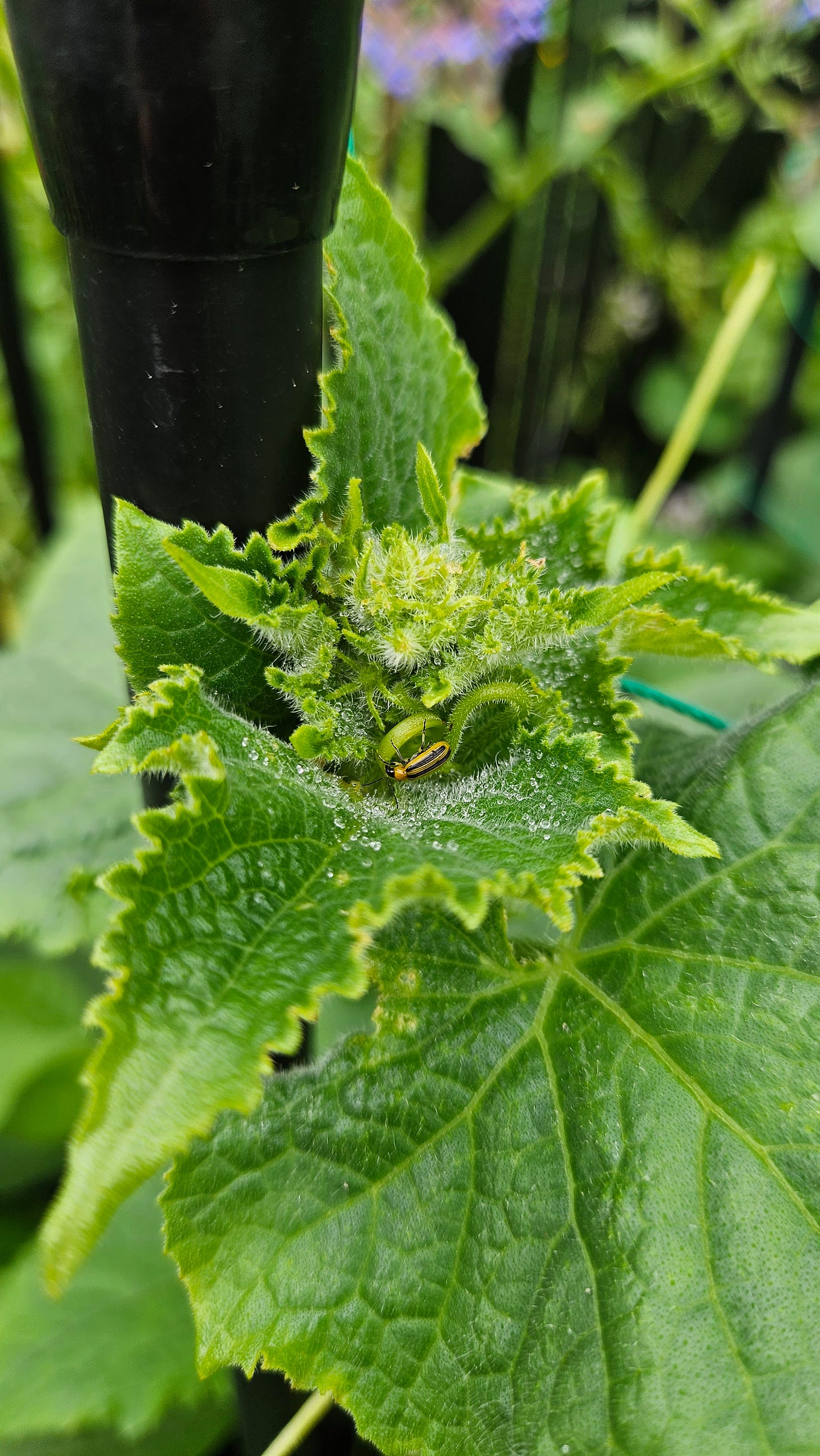
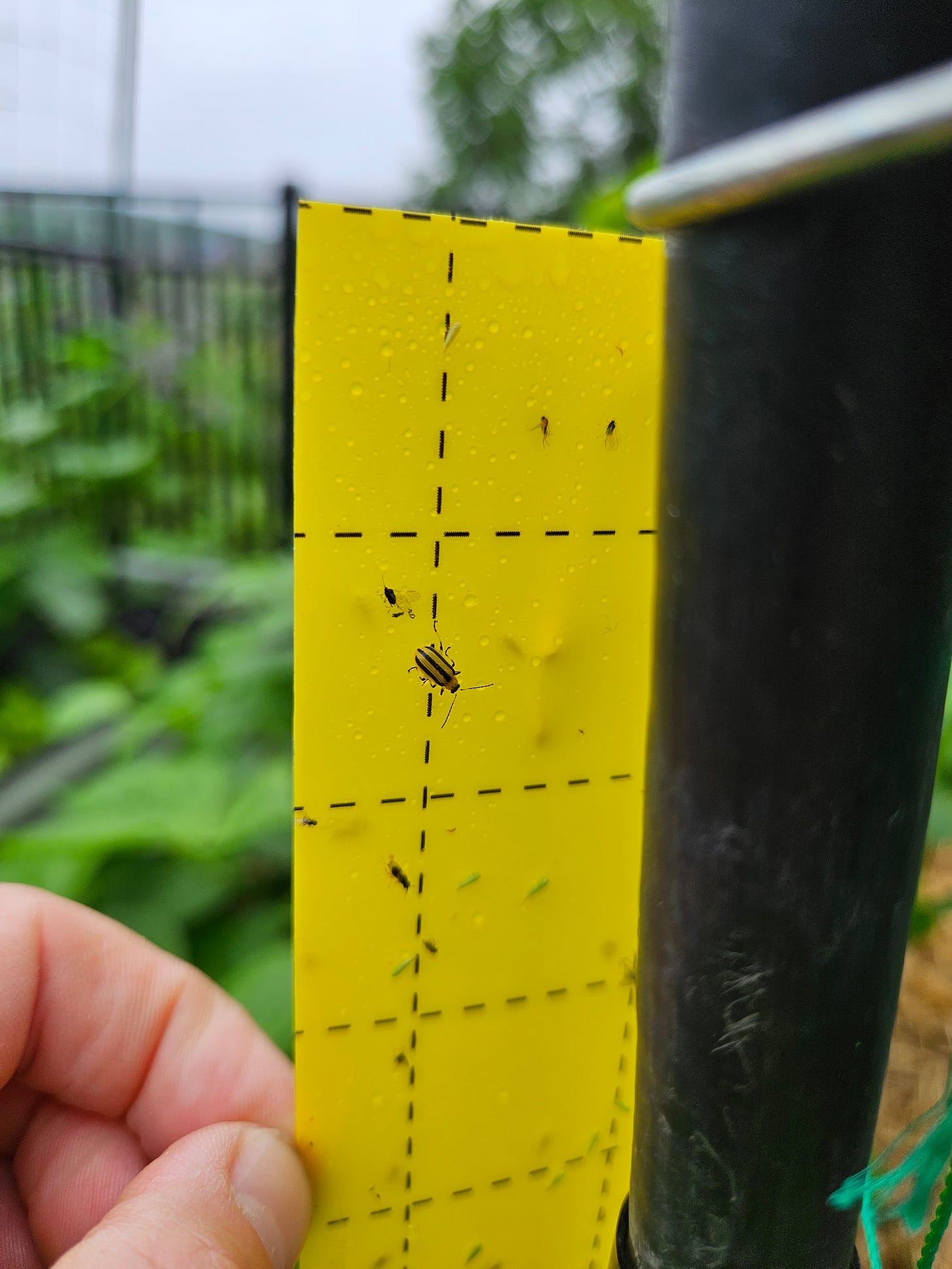
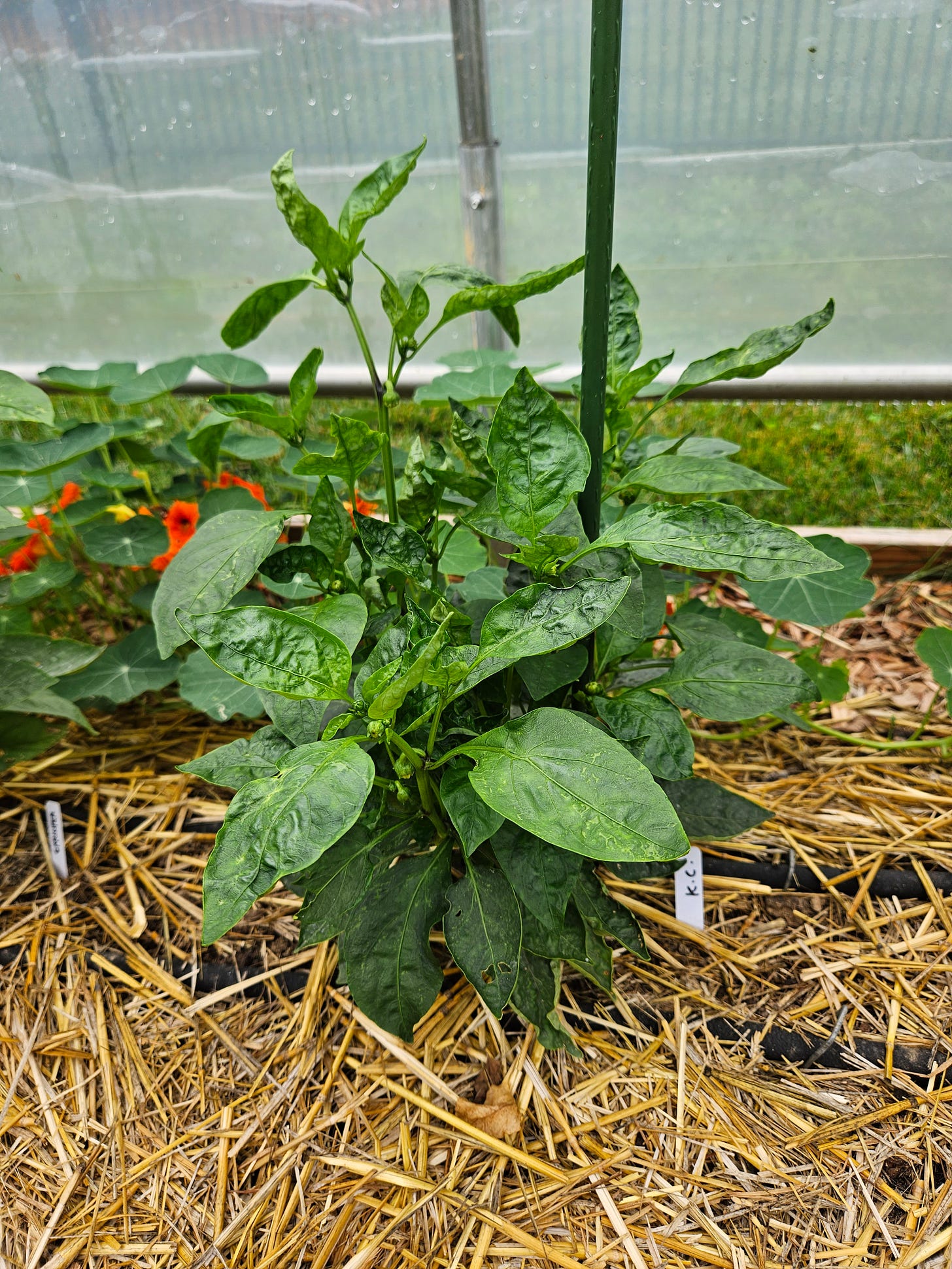
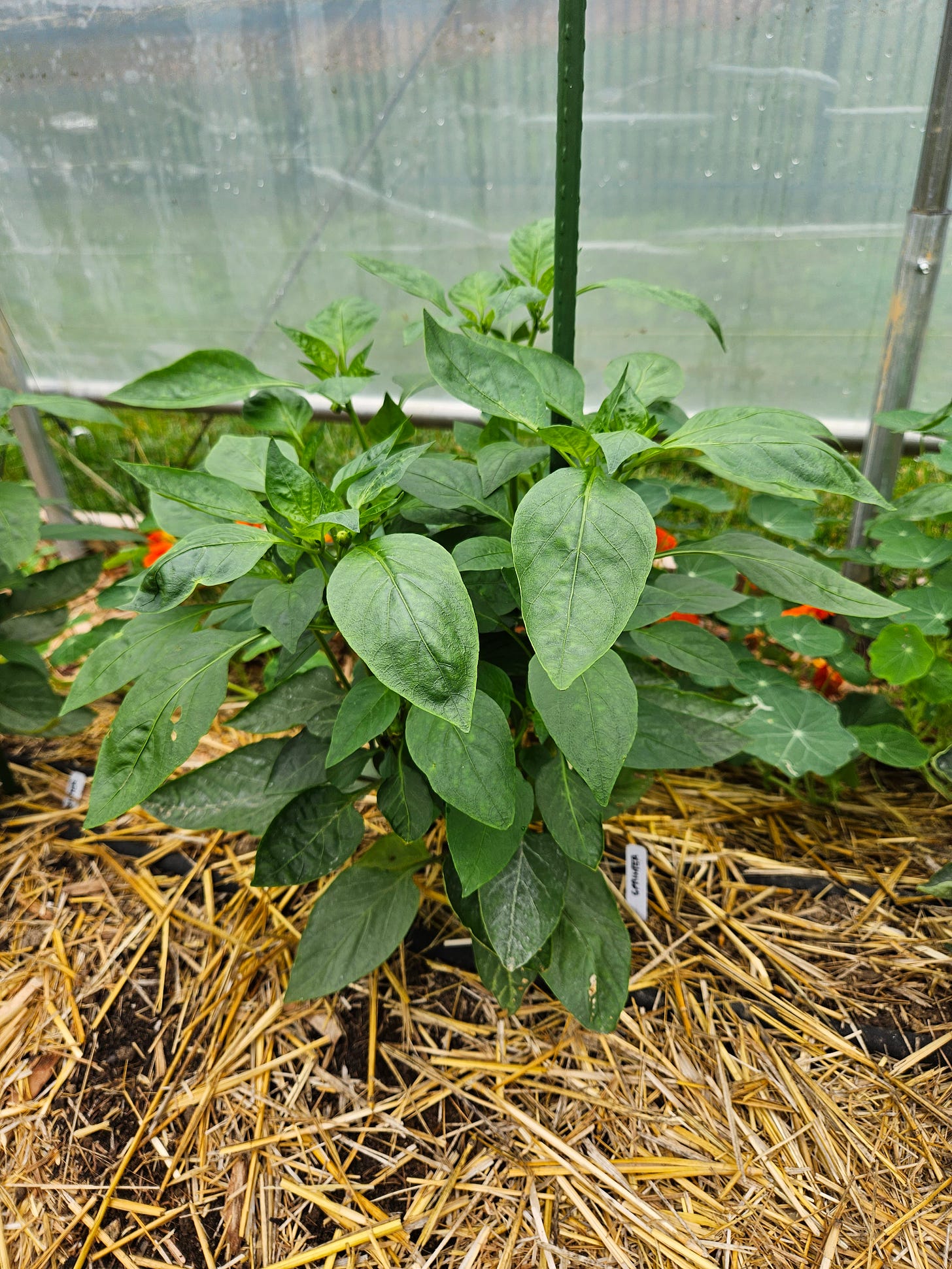
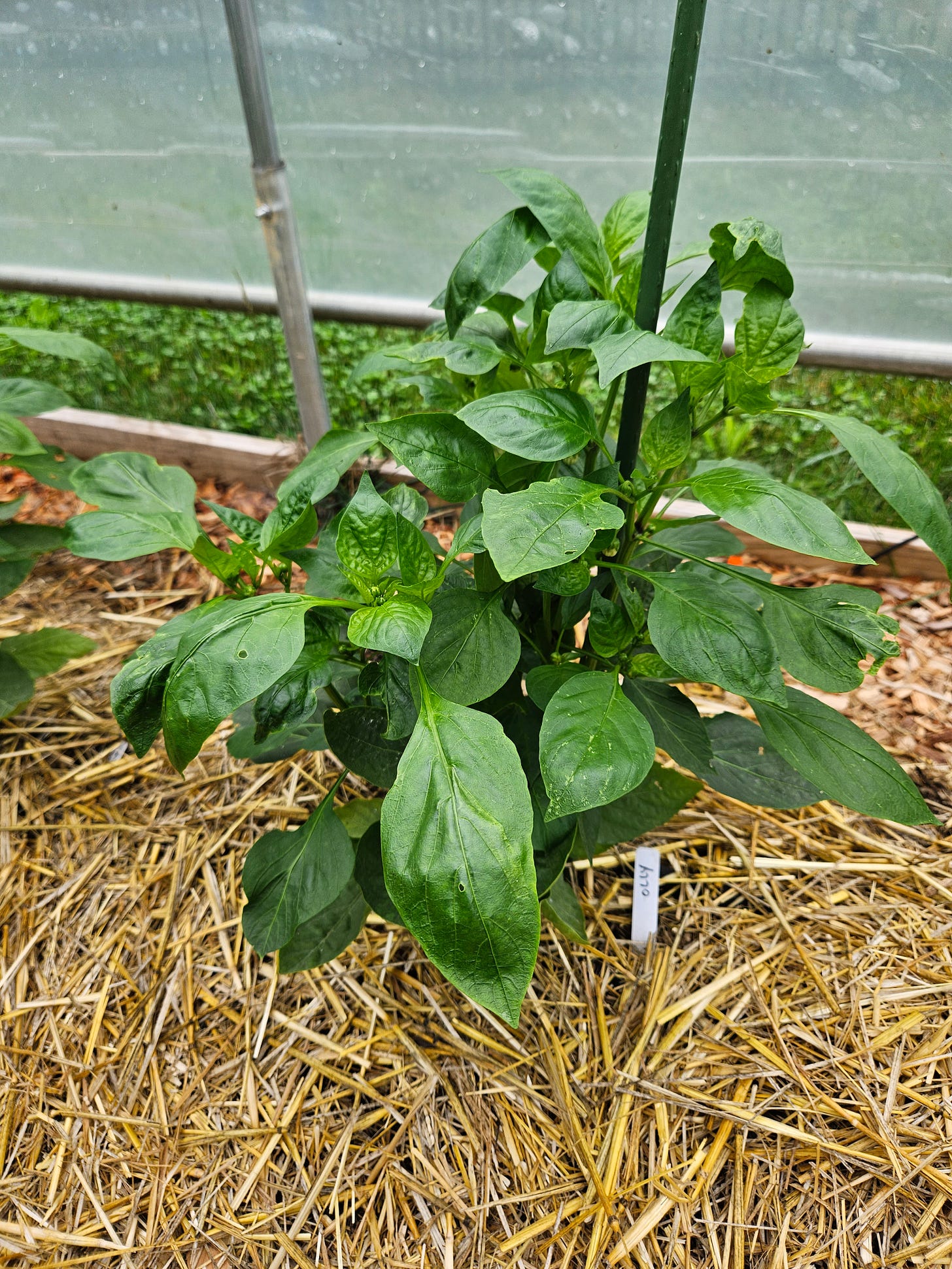
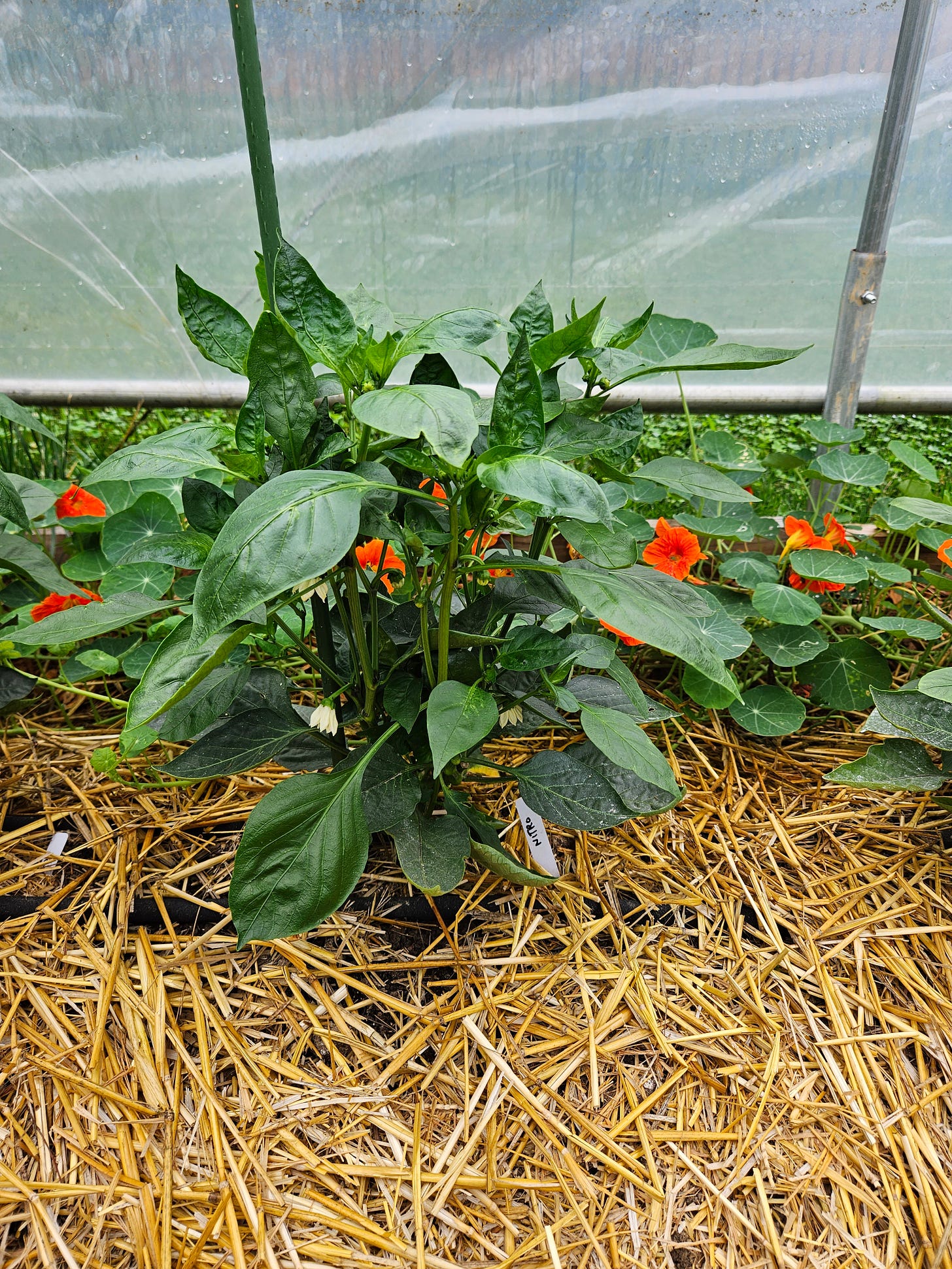
What a wonderful garden year you're having! Great job!
I'm in awe! Everything looks amazing! So nice to see the Robin's nest, too.